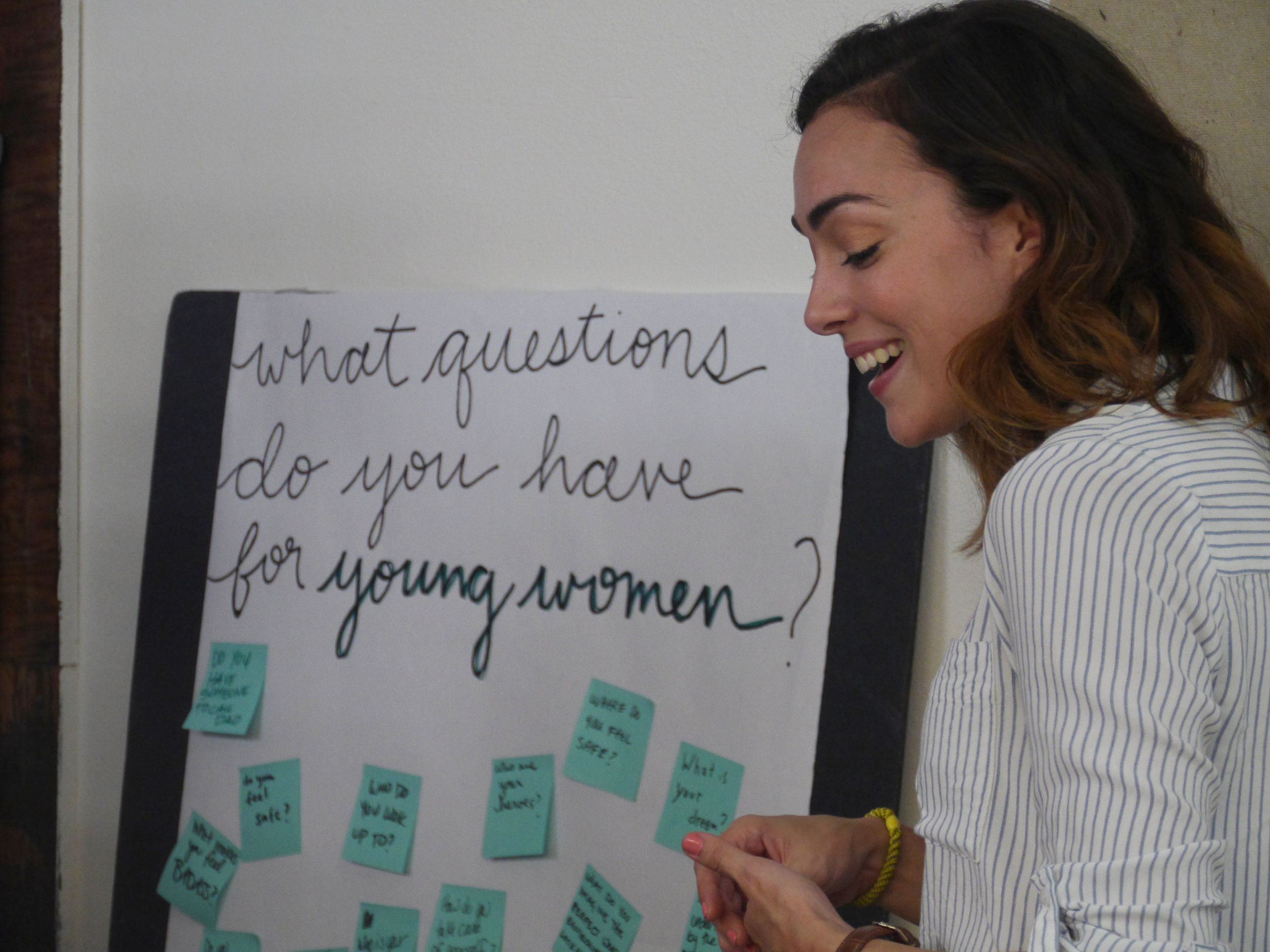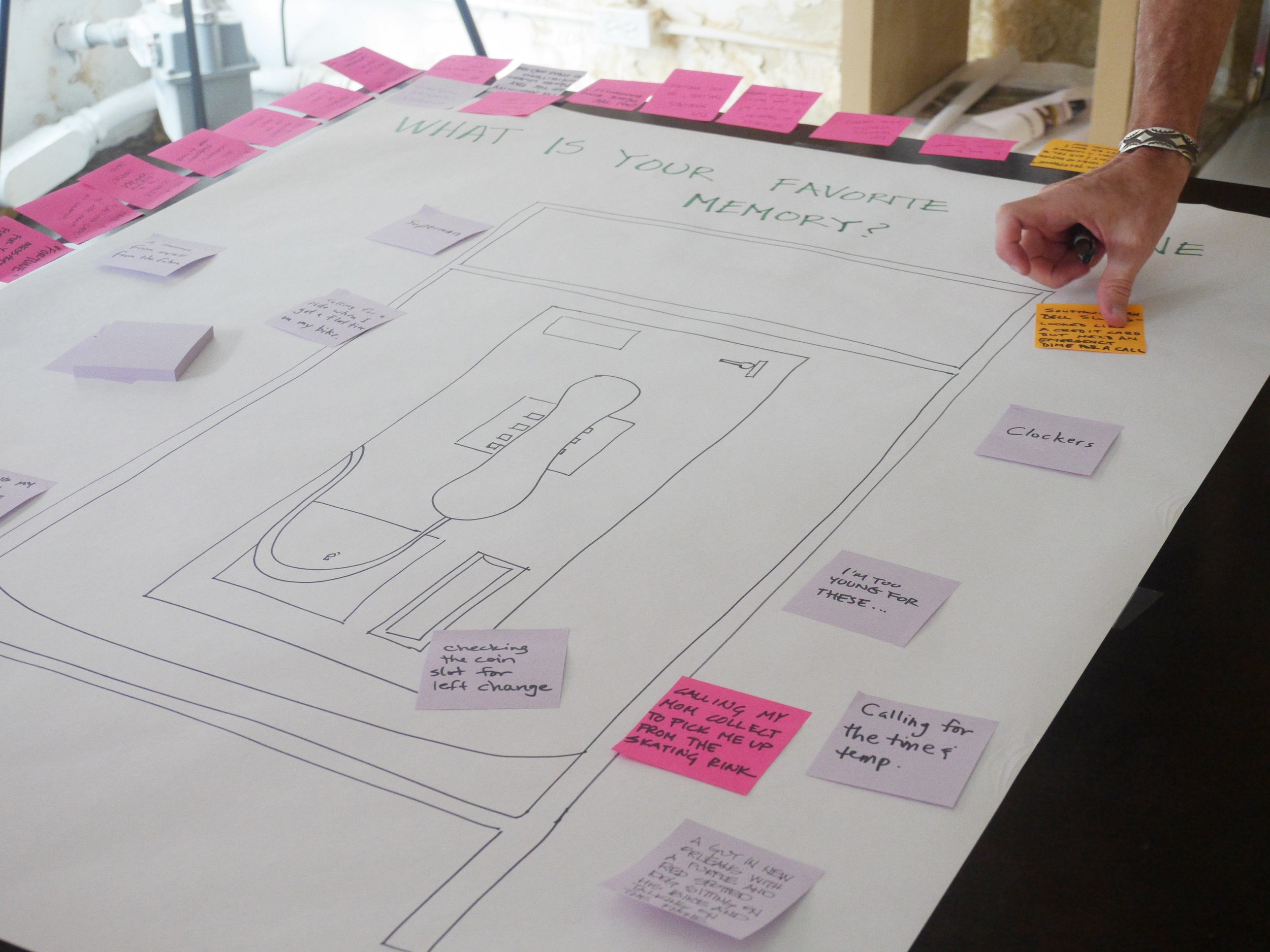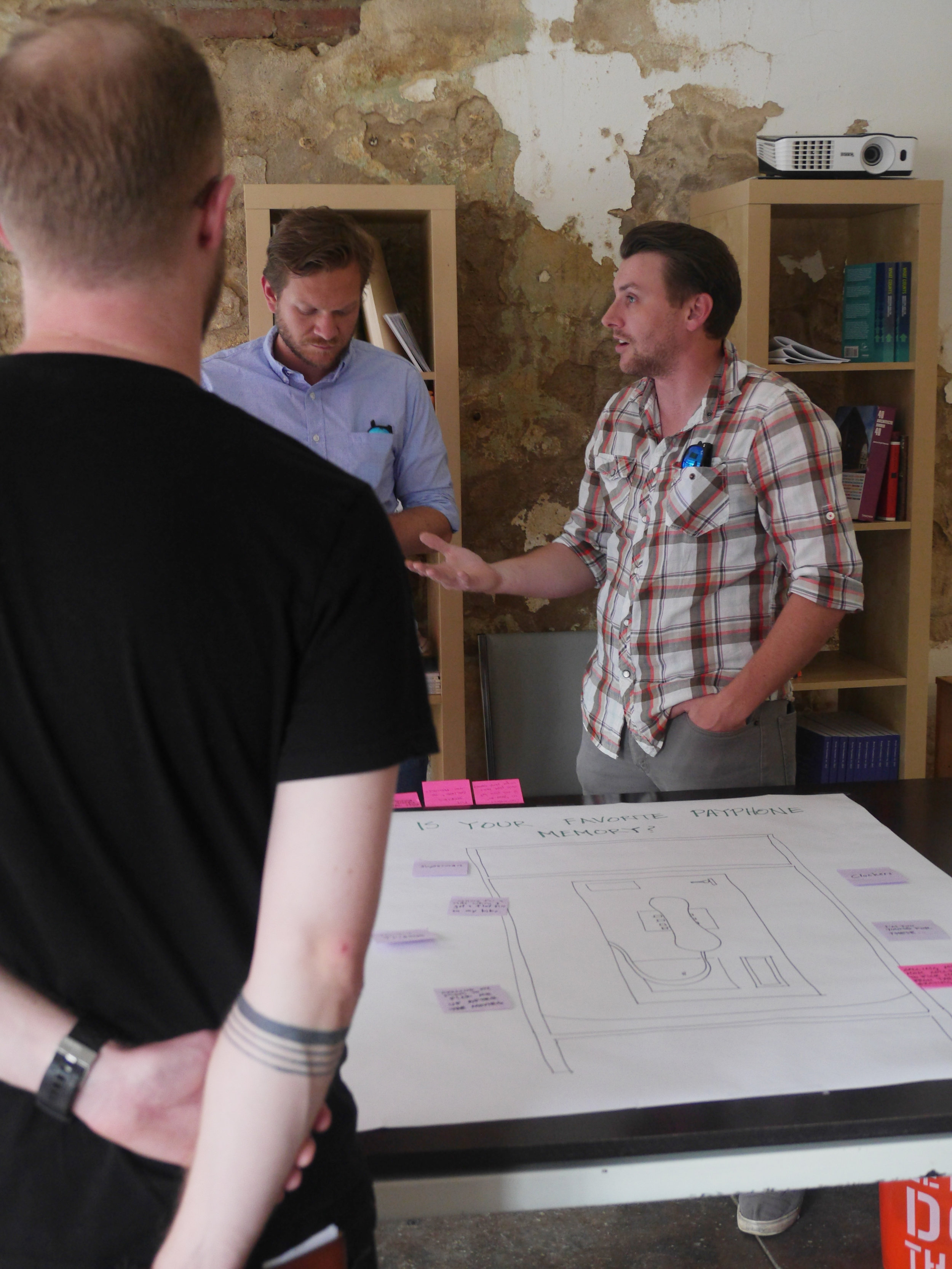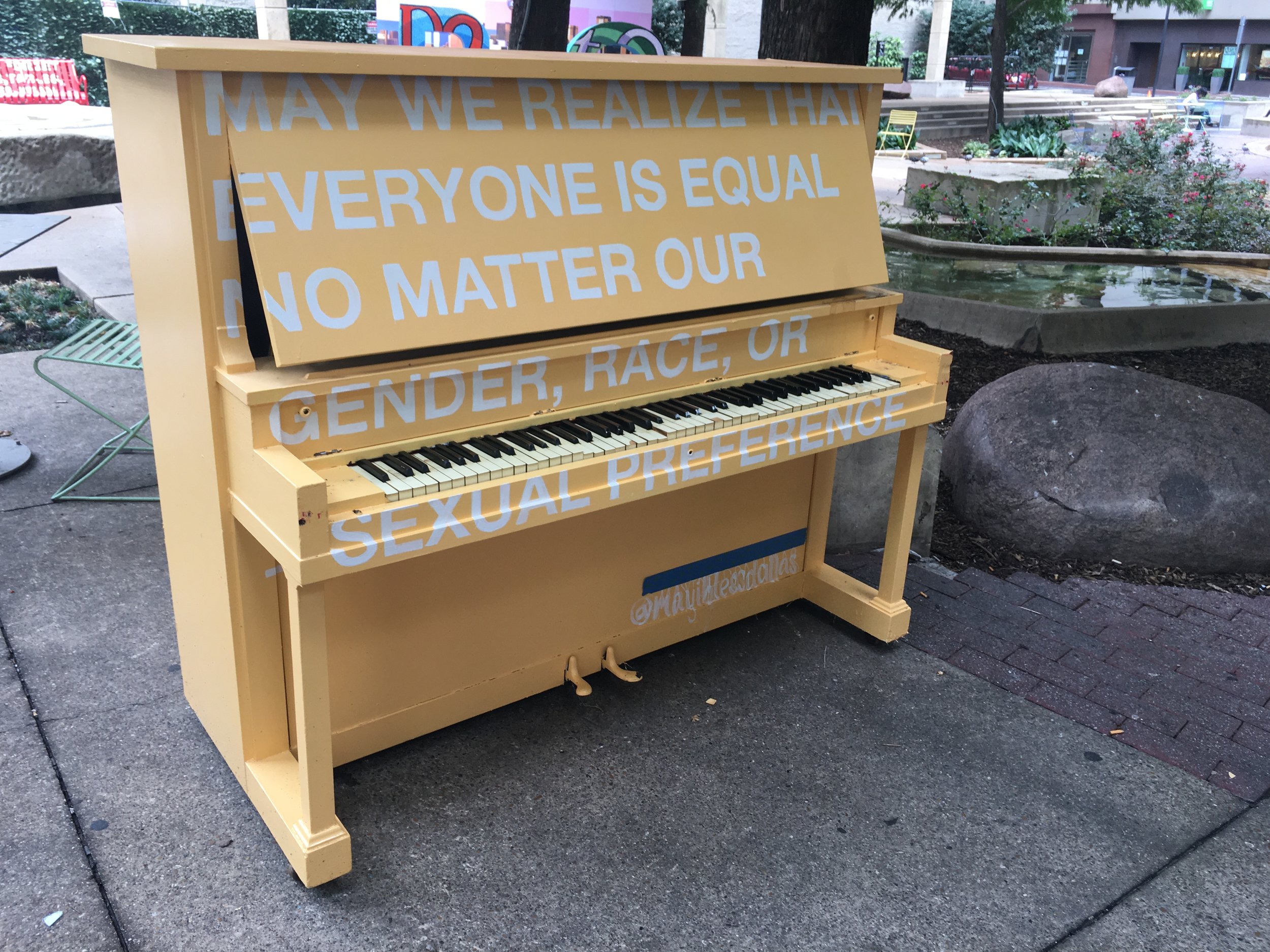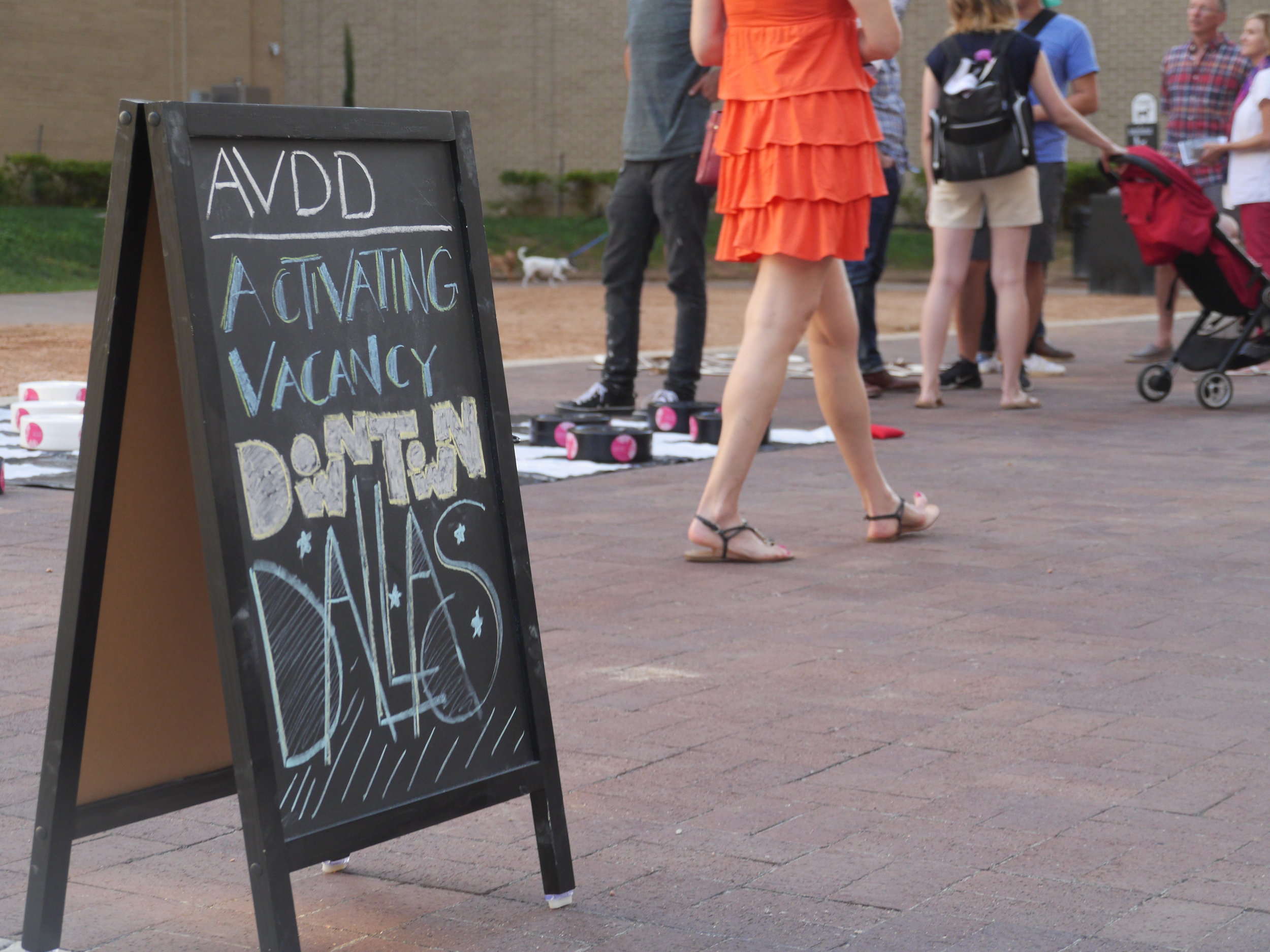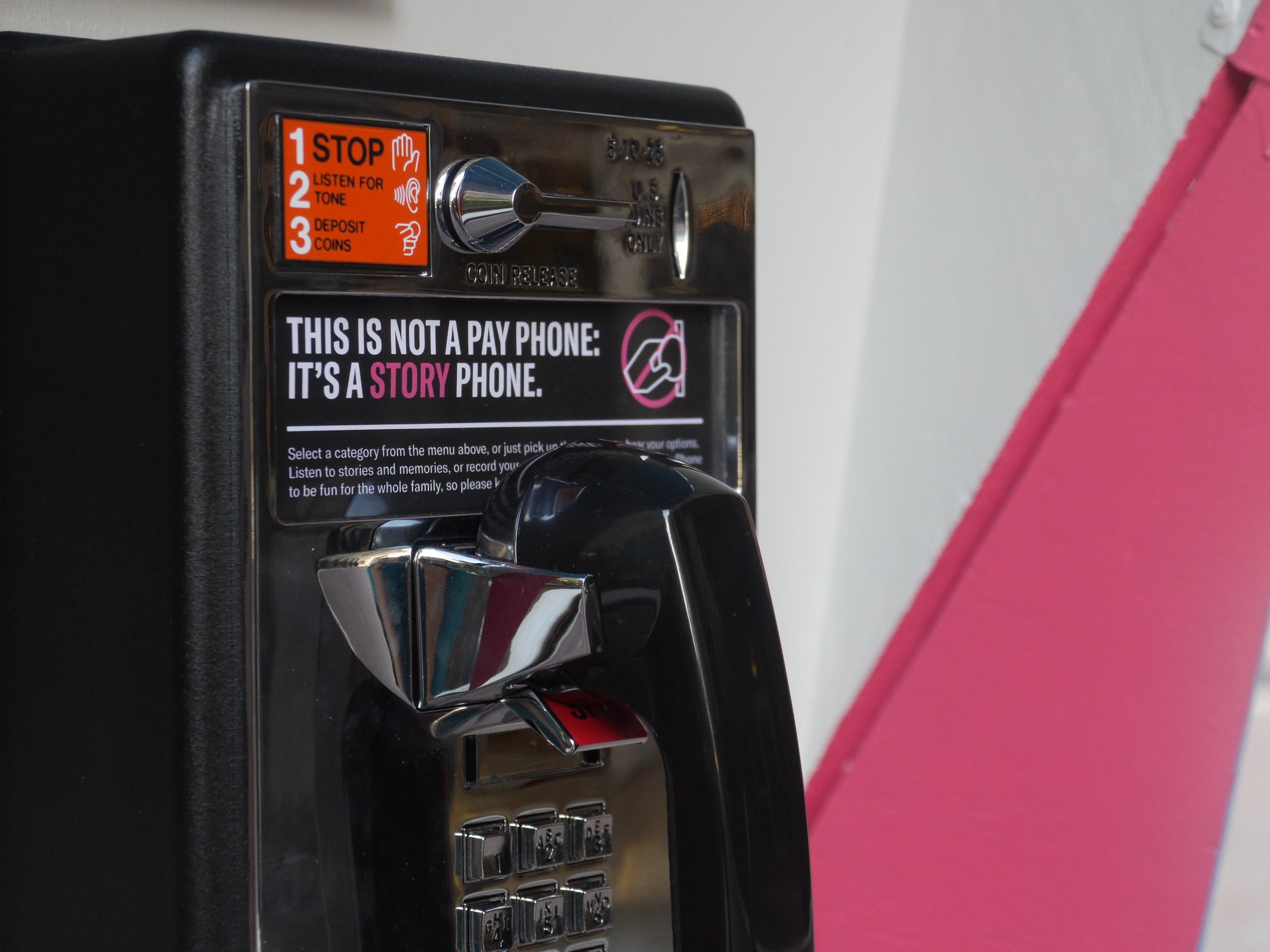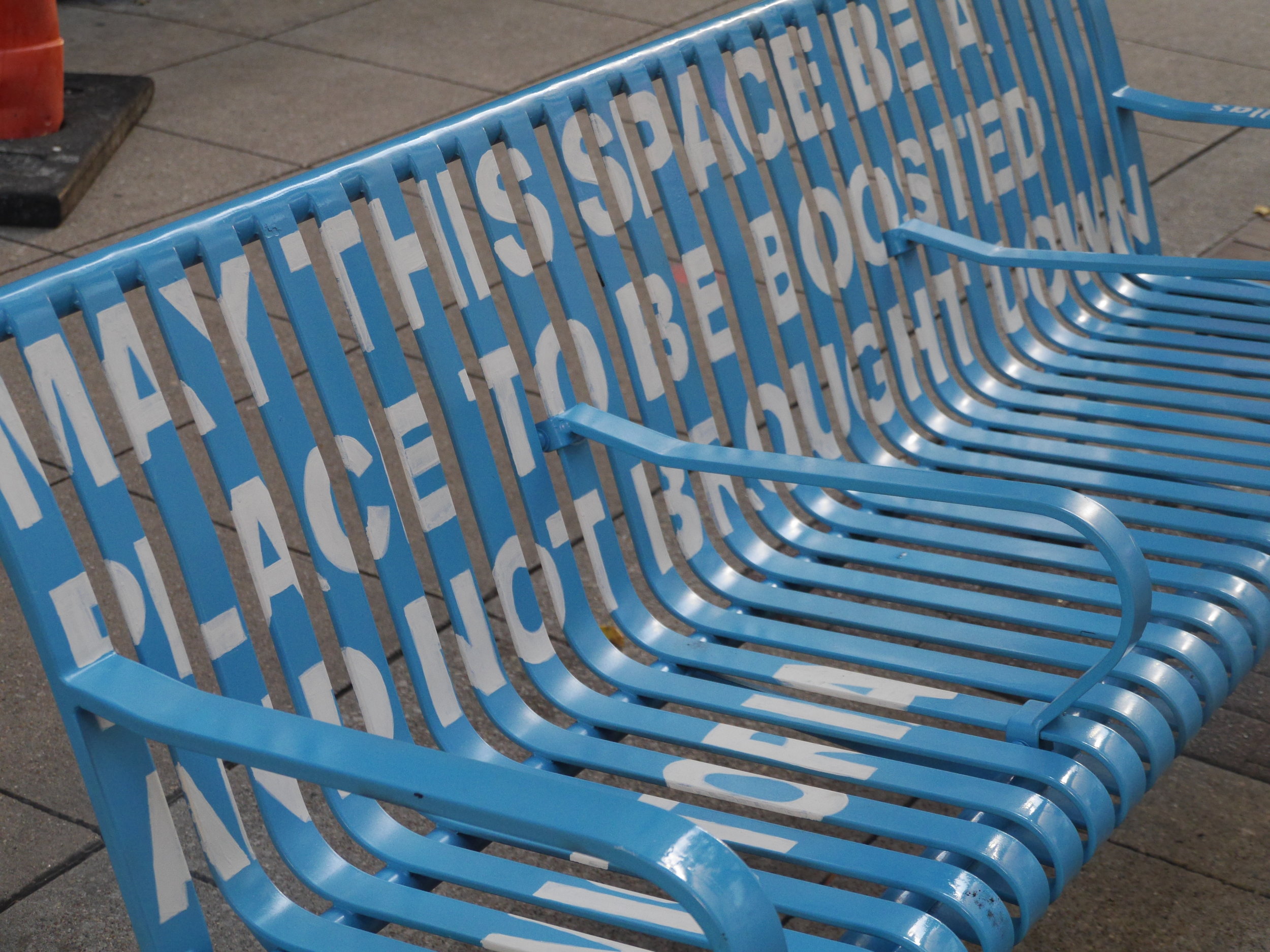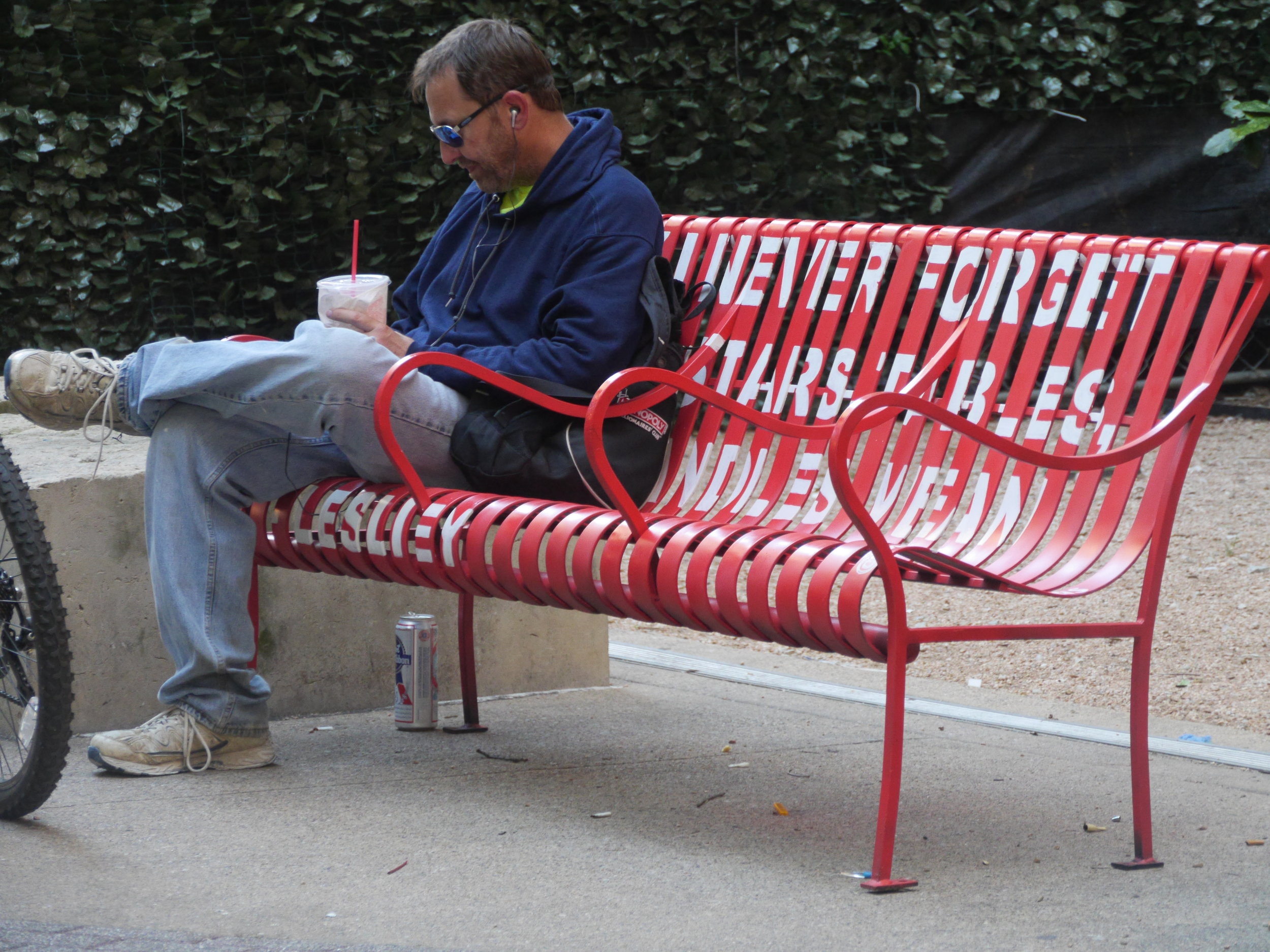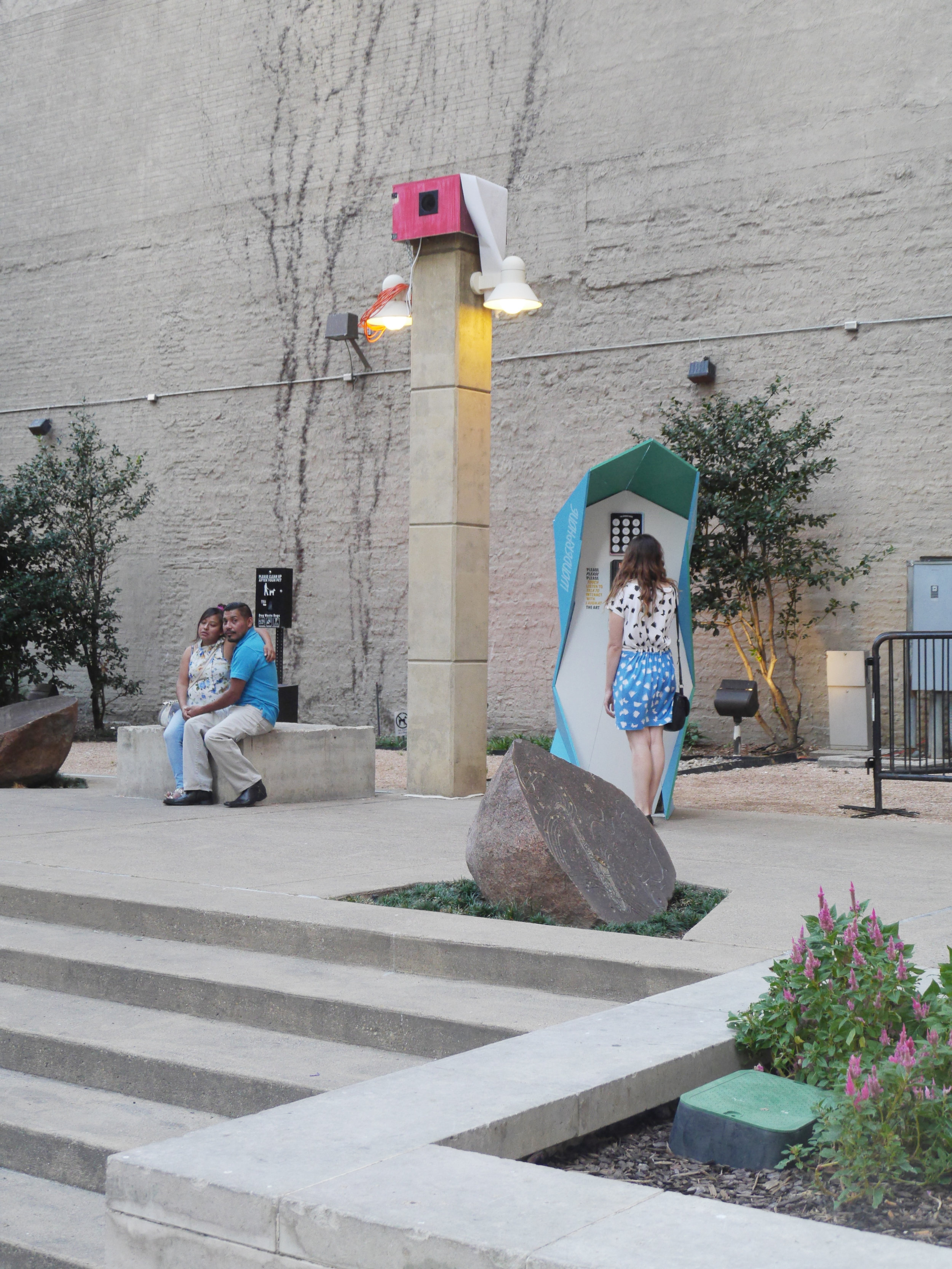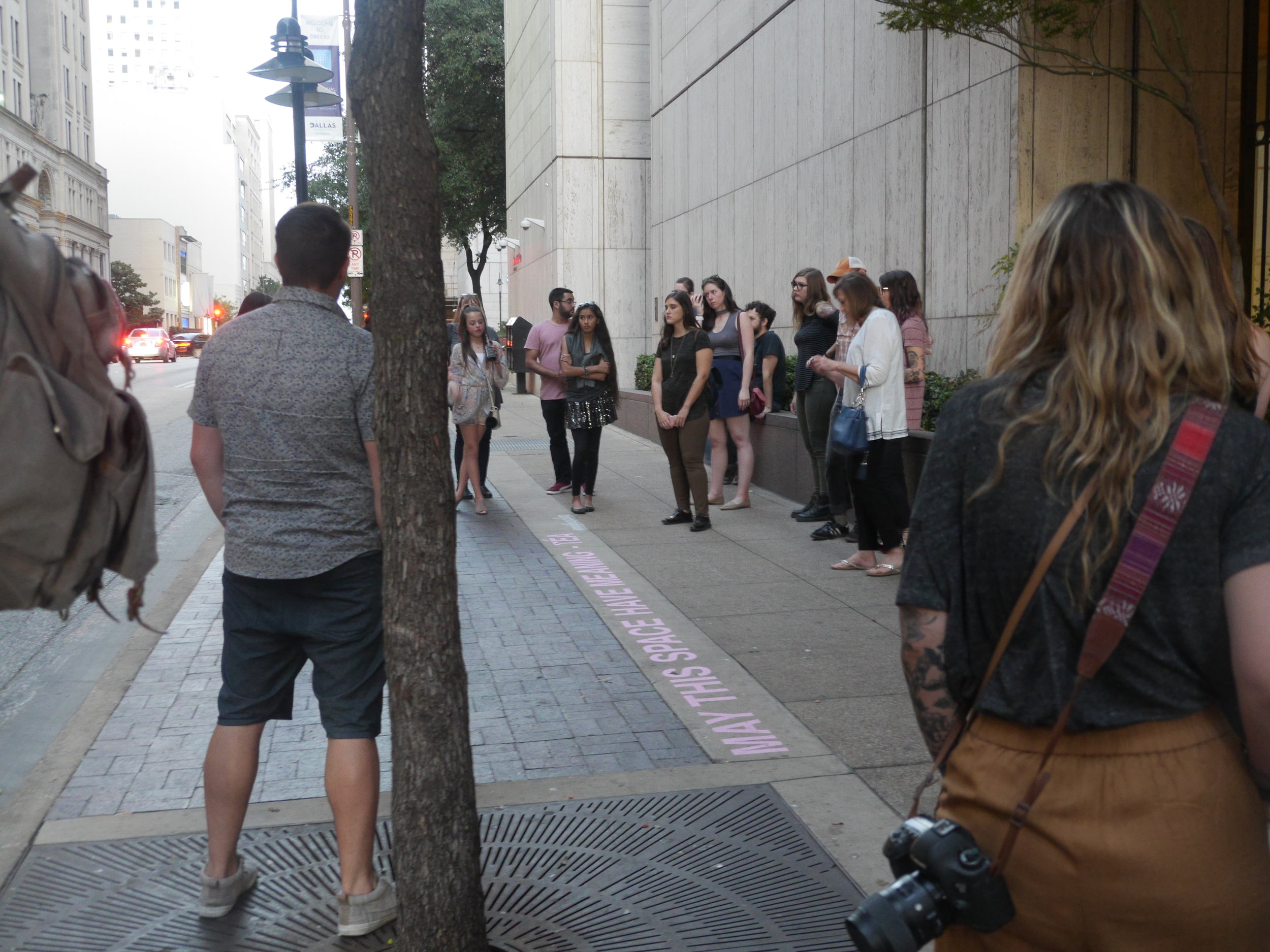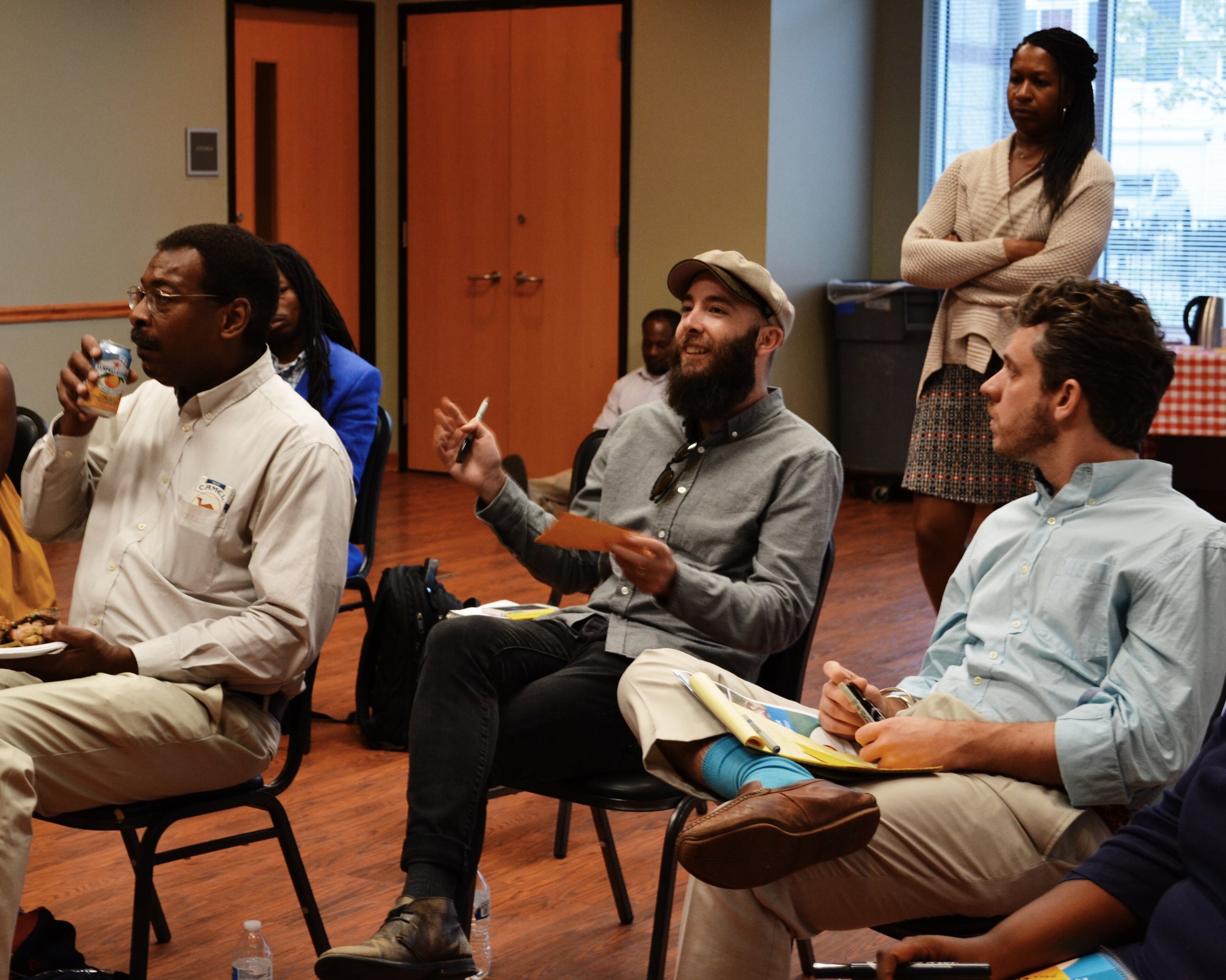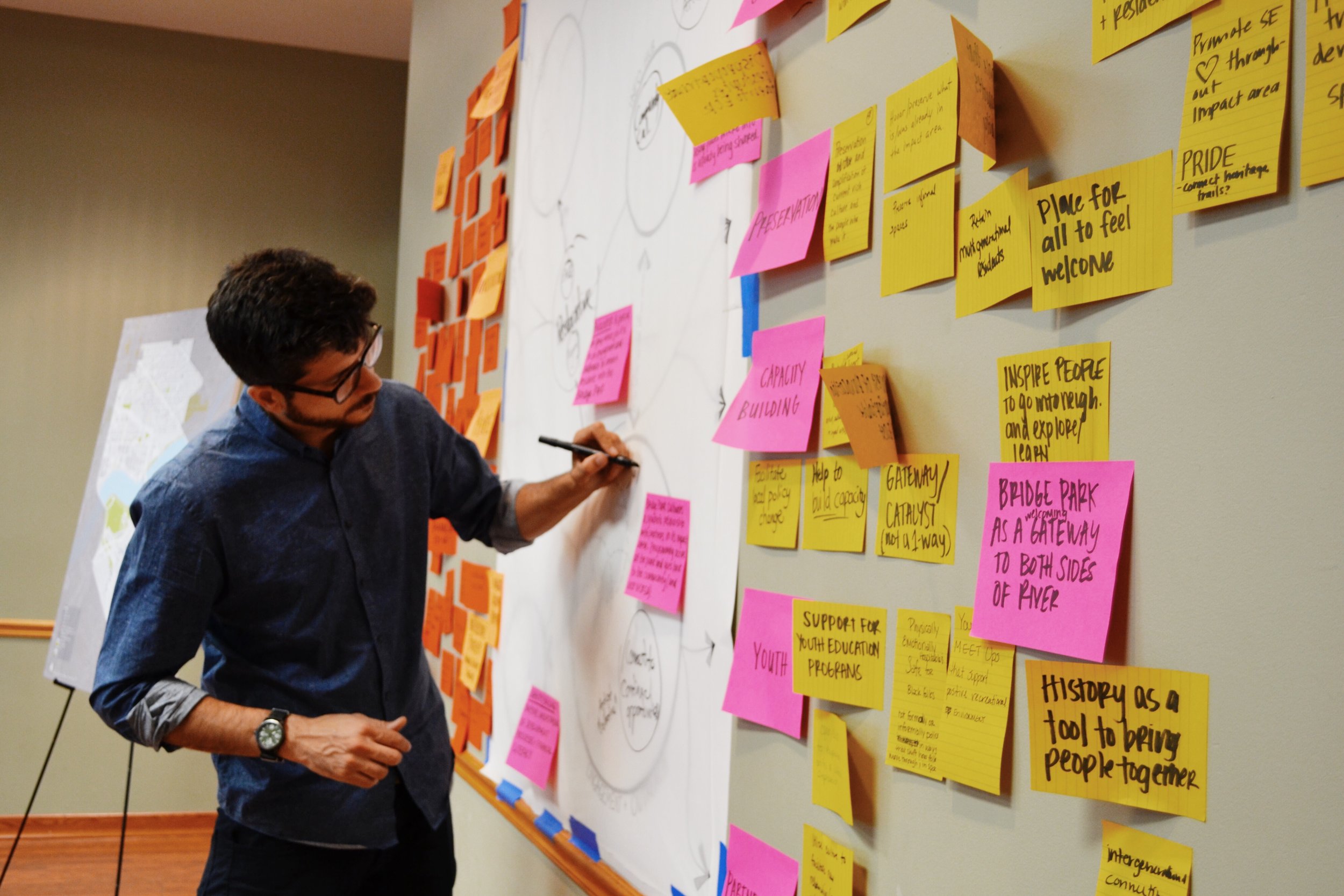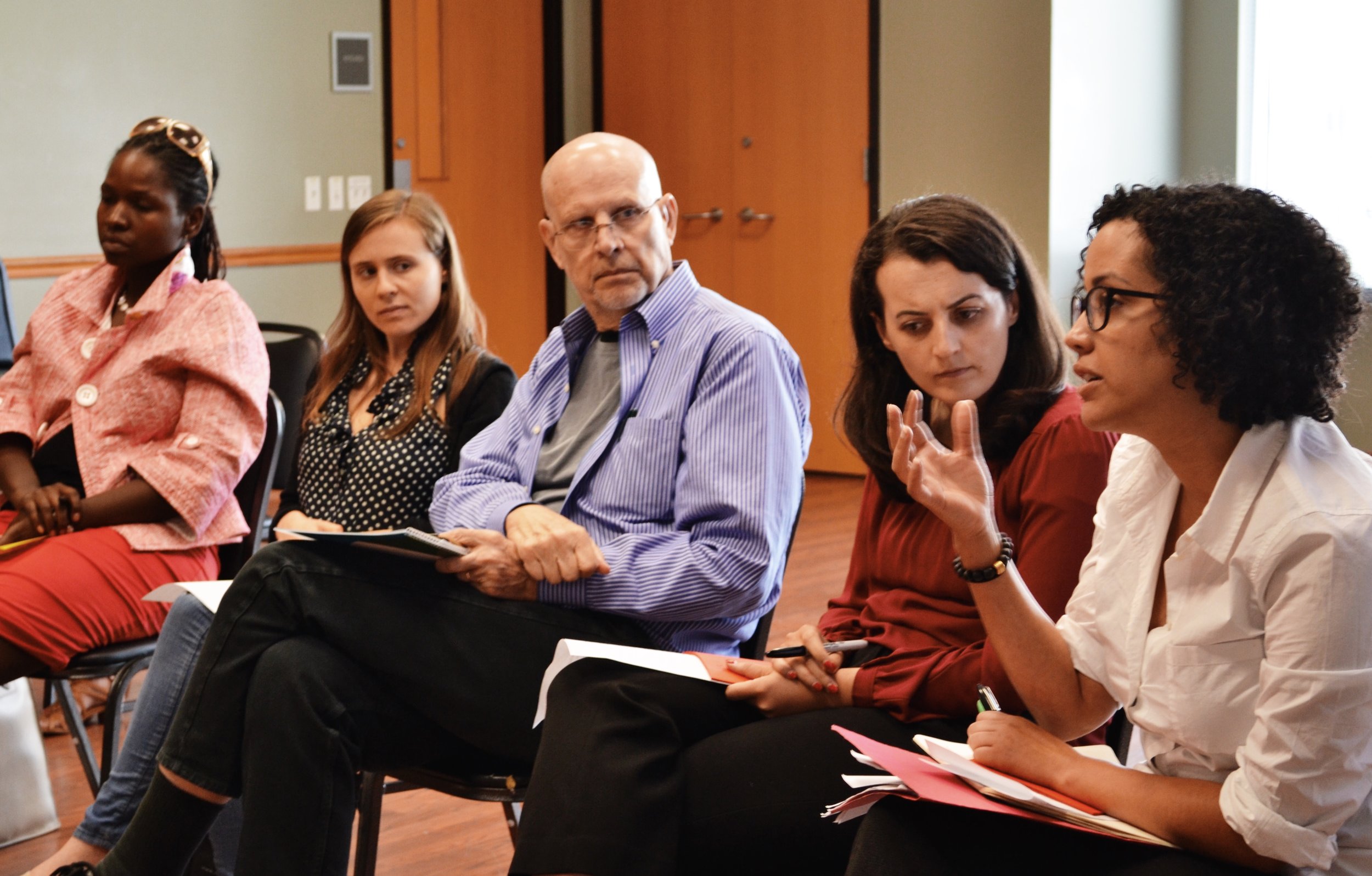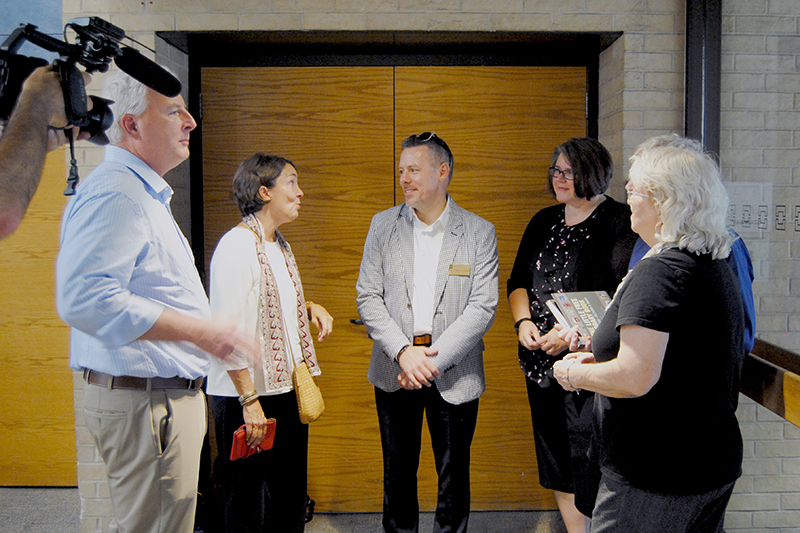Dolphin Heights Neighborhood Association is raising funds to support the design/build of a 450 square foot garden cottage. A resident gardener will live and work onsite in exchange for reduced rent. Learn how the project’s going here!
Read MorePlace Setting: Summer Book Club Schedule
Join us for the Place Setting Book Club in summer 2020, part of our NEA-funded project in Downtown Dallas.
Read MoreActivating Downtown Dallas II Now Underway!
Learn about how we’re activating Pegasus Plaza in Downtown Dallas along with our partner, Downtown Dallas, Inc.
Read MoreEl Sonido del Agua Update
We’ve got an update on the El Sonido del Agua project, our multi-year initiative in the Rio Grande Valley funded by ArtPlace America.
Call to Action fliers passed out at local events
Since the January 26th kick-off celebration, El Sonido del Agua has become an advocacy tool for our partner organizations (ARISE and LUPE) to use for members of the Alberta Meadows and Owassa Acres colonias in their continued fight for improved drainage infrastructure.
Content which includes the six original corridos (songs in the Conjunto tradition) and call to action pamphlets have been shared at local events to encourage other colonias in Hidalgo County to inform residents of their power and ability to make infrastructural improvements in their communities.
Here’s an example of some of the lyrics in the corridos:
Los niños estaban muy desconsolados
Pues sus vacaciones no podían disfrutar
Nubes de zancudos lombrices y ratas
Cubría el terreno imposible jugar
(The children were gloomy
Since their vacations could not be enjoyed
Clouds of mosquitoes, worms, and rats
Made the ground an impossible place to play)
Las inundaciones son un gran problema
Buscando el apoyo se puede arreglar
Uniendo a la LUPE junto con Arise
y con bcWorkshop lo resolveran
(Floodings are a big issue
Looking for support, we can find solutions
Uniting the LUPE together with ARISE
and with bcWorkshop they will be solved)
The project is set to culminate this fall with a final celebration with one final song recorded that expresses the community’s continued mobilization to make positive changes, as well as to solidify the two colonias’ pride for the efforts they have put forth to make El Sonido del Agua a tool, artistic expression, and a movement to fight for equitable infrastructure. Stay tuned for more updates from this exciting project!
Citizens' Institute on Rural Design (CIRD) Finalists Announced
After lots of application review and interviews, [bc] along with the Housing Assistance Council (HAC) and the National Endowment for the Arts are pleased to announce that 23 communities have been selected to take part in the Citizen’s Institute on Rural Design (CIRD).
CIRD has worked with communities of 50,000 or less since 1991 to enhance quality of life and economic viability through planning, design, and creative placemaking. This is our first year partnering with HAC to lead the Institute.
The following three communities will take part in multi-day design workshops in the communities to focus on their specific challenges.
Millinocket, Maine (population 4,400): The residents of Millinocket, located near Maine’s Mount Katahdin, have mobilized around sustainability, mental health/wellness, and diversifying the town’s economic base after the departure of the paper industry. The goal is to create a design principles guidebook that will inform downtown revitalization plans and be used by local businesses to help create a unified sense of place.
Pueblo of Laguna, New Mexico (population 1,241): The Pueblo is developing an ambitious master plan for the Village of Laguna (one of six in the Pueblo) that seeks to address longstanding challenges, including a dearth of affordable housing and the need for both walkability and commercial space that builds on indigenous cultural assets such as artisanship and arid-land farming. The University of New Mexico’s Indigenous Design + Planning Institute will join local institutions to support the workshop.
Athens, Ohio (population 23,832): Mt. Zion Baptist Church Preservation Society wants to preserve and reimagine the use of a century-old church built by free-born and formerly enslaved black artisans. In addition to architectural rehabilitation, the Preservation Society and its partners envision the place as an economic engine and as a hub for black history and culture.
It was a competitive application process, as 85 applications were received — a record for CIRD. New this year, 20 additional communities were chosen to take part in a peer-learning cohort and will attend a Rural Design Summit in West Virginia this October 9-11.
We are excited to be part of this amazing team and can’t wait to delve into the design challenges in the upcoming workshops and the peer-learning cohort.
Apply Now for the Citizens' Institute on Rural Design!
The Citizens’ Institute on Rural Design is accepting applications through July 22 — learn how your town can apply right here!
Read MoreEl Sonido del Agua
We are excited to share that on Saturday, January 26, buildingcommunityWORKSHOP ([bc]), La Unión del Pueblo Entero (LUPE), A Resource in Serving Equality (ARISE), the Narciso Martinez Cultural Arts Center, and Texas Housers, with the support of UTHealth School of Public Health, UTRGV School of Medicine, and UTRGV-Cameron County will host a conjunto music celebration as part of the El Sonido del Agua project.
The celebration event will mark the live debut of six original songs that have been written through El Sonido del Agua—a multiyear initiative funded by the ArtPlace America National Creative Placemaking Fund which aims to mobilize and equip residents of the Lower Rio Grande Valley’s colonias to tackle public health issues that arise from inadequate infrastructure. The lyrics of the songs composed tell the story of what colonia residents experience—the day-to-day challenges of living in these substandard subdivisions, such as flooding and a lack of street lighting. Project partners and participants hope to utilize these songs to draw attention to inequities of place and build momentum for colonia residents’ organizing campaigns to win change for their communities.
At the event, the four musicians commissioned through the project, who have worked alongside residents over the past several months to craft lyrics, will play the corridos for a live audience. Project partner organizations will speak about the goals of the project and the suite of events that will be taking place over the next few months as part of the effort.
Bridging the Block Wrap-Up
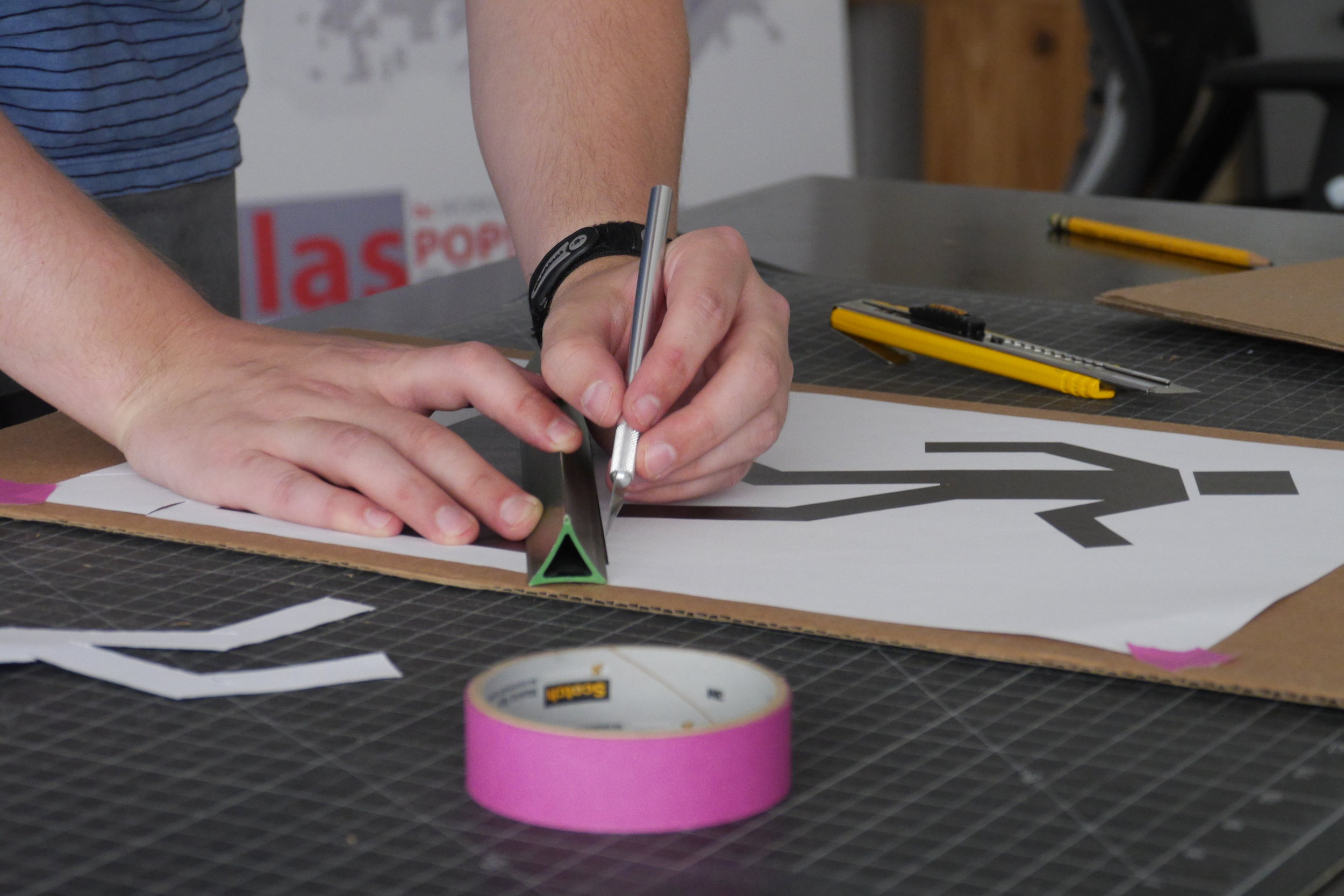
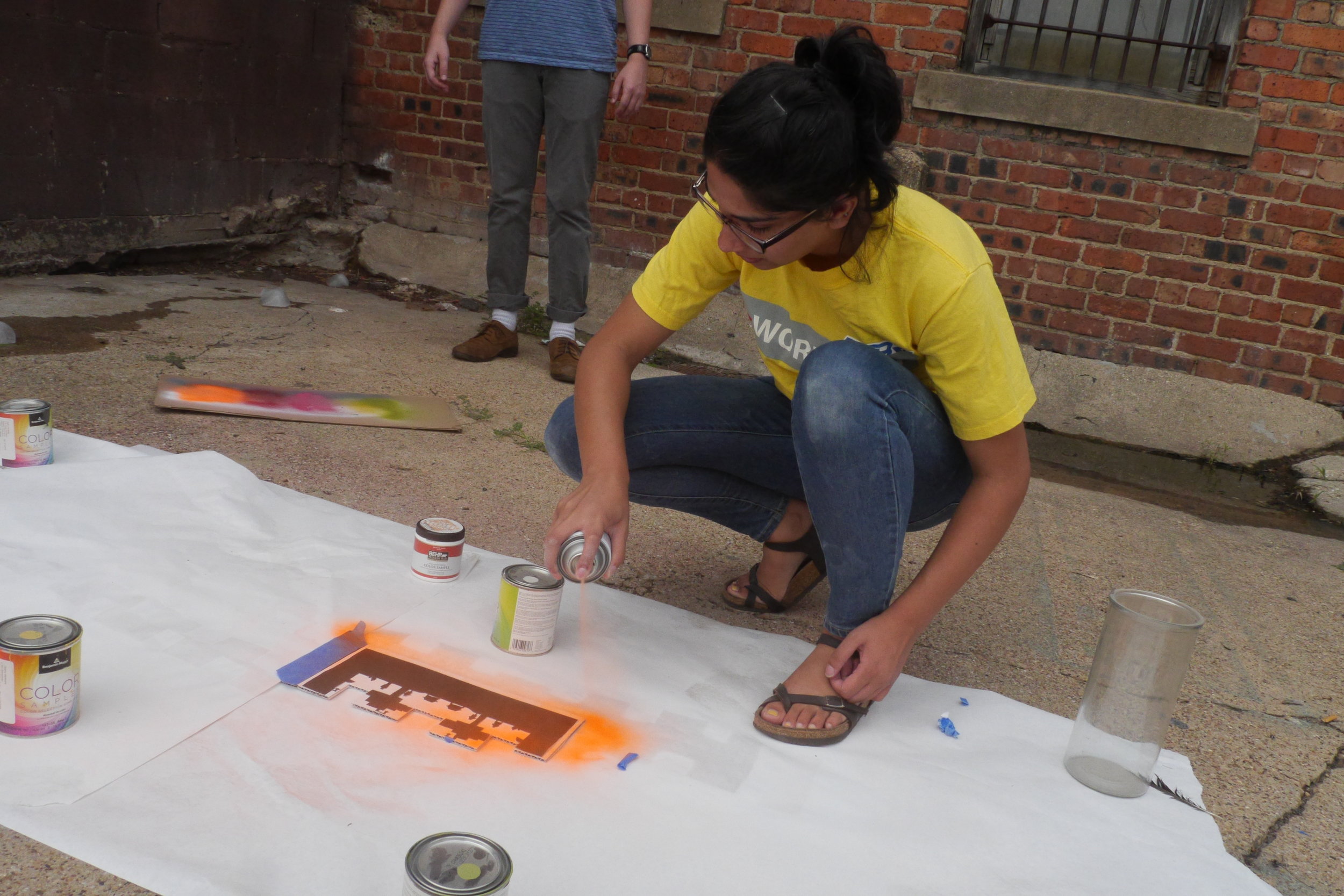
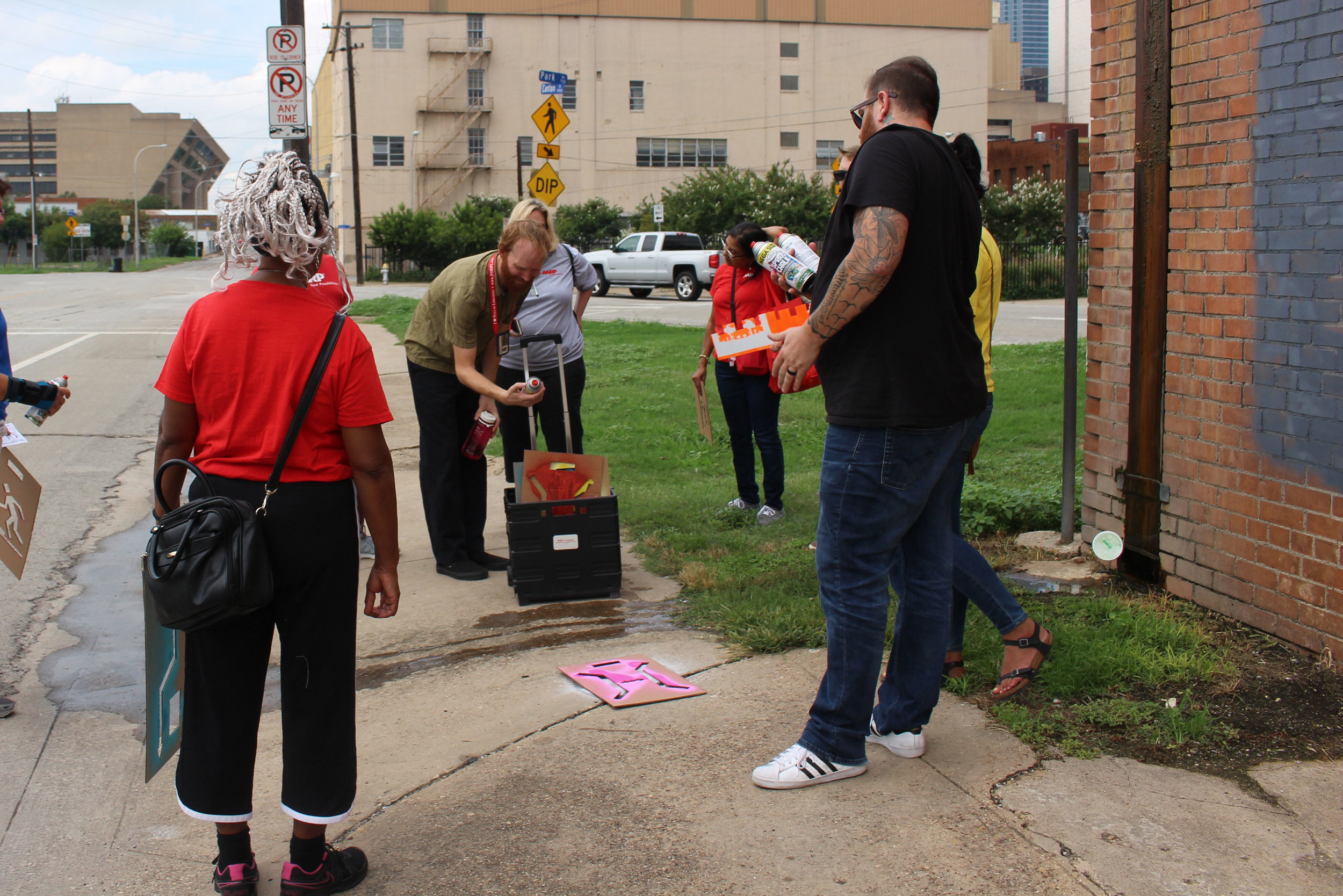


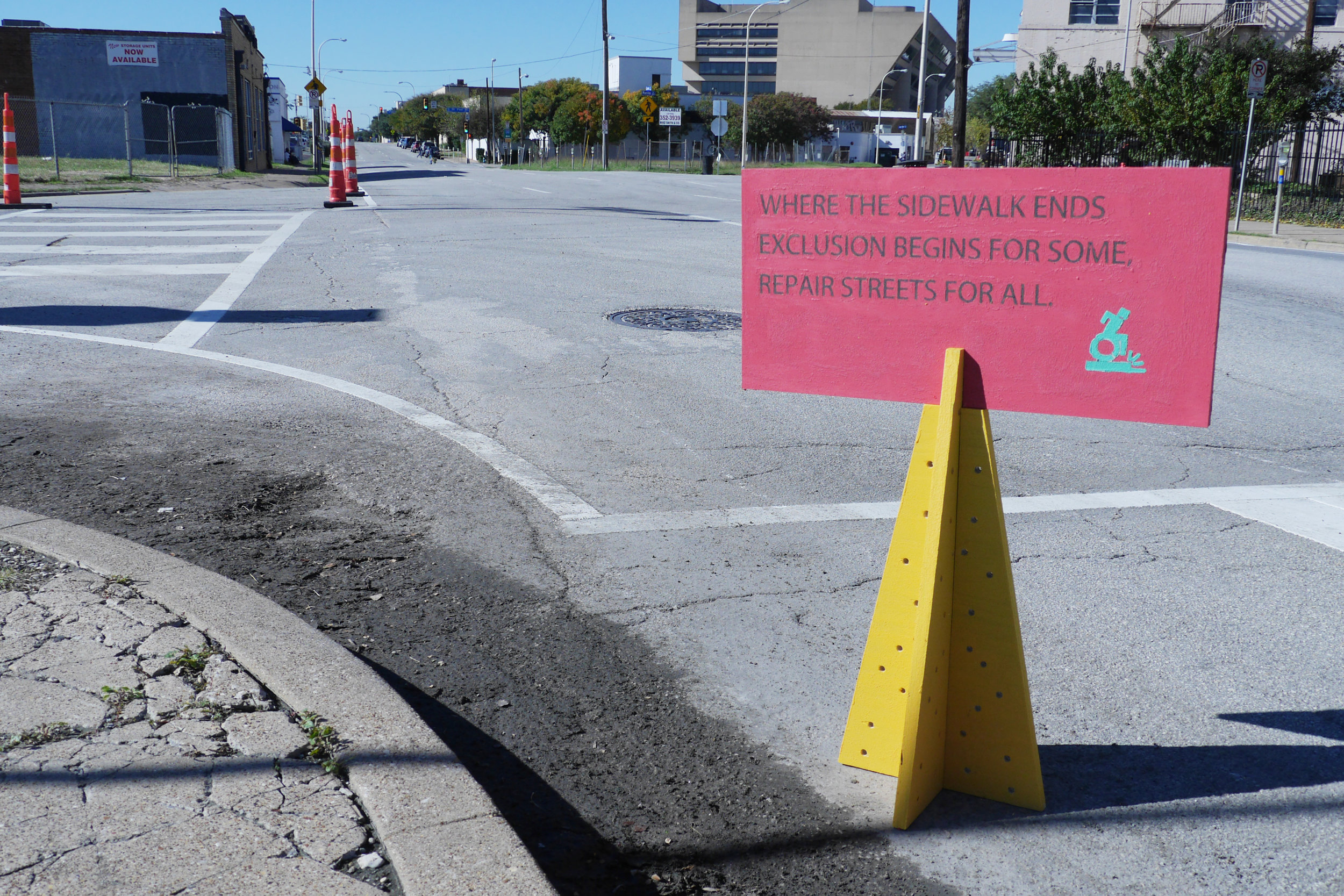
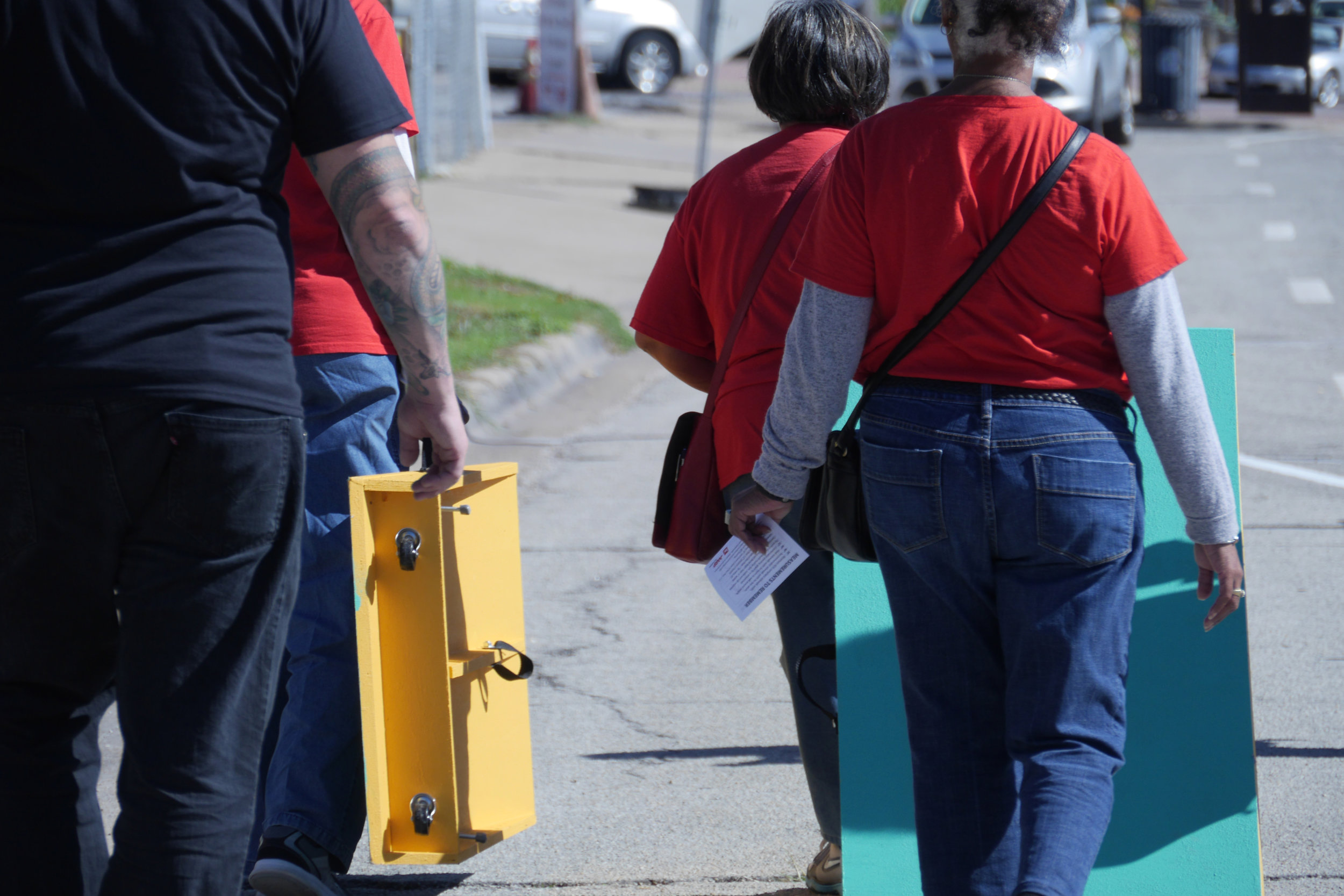

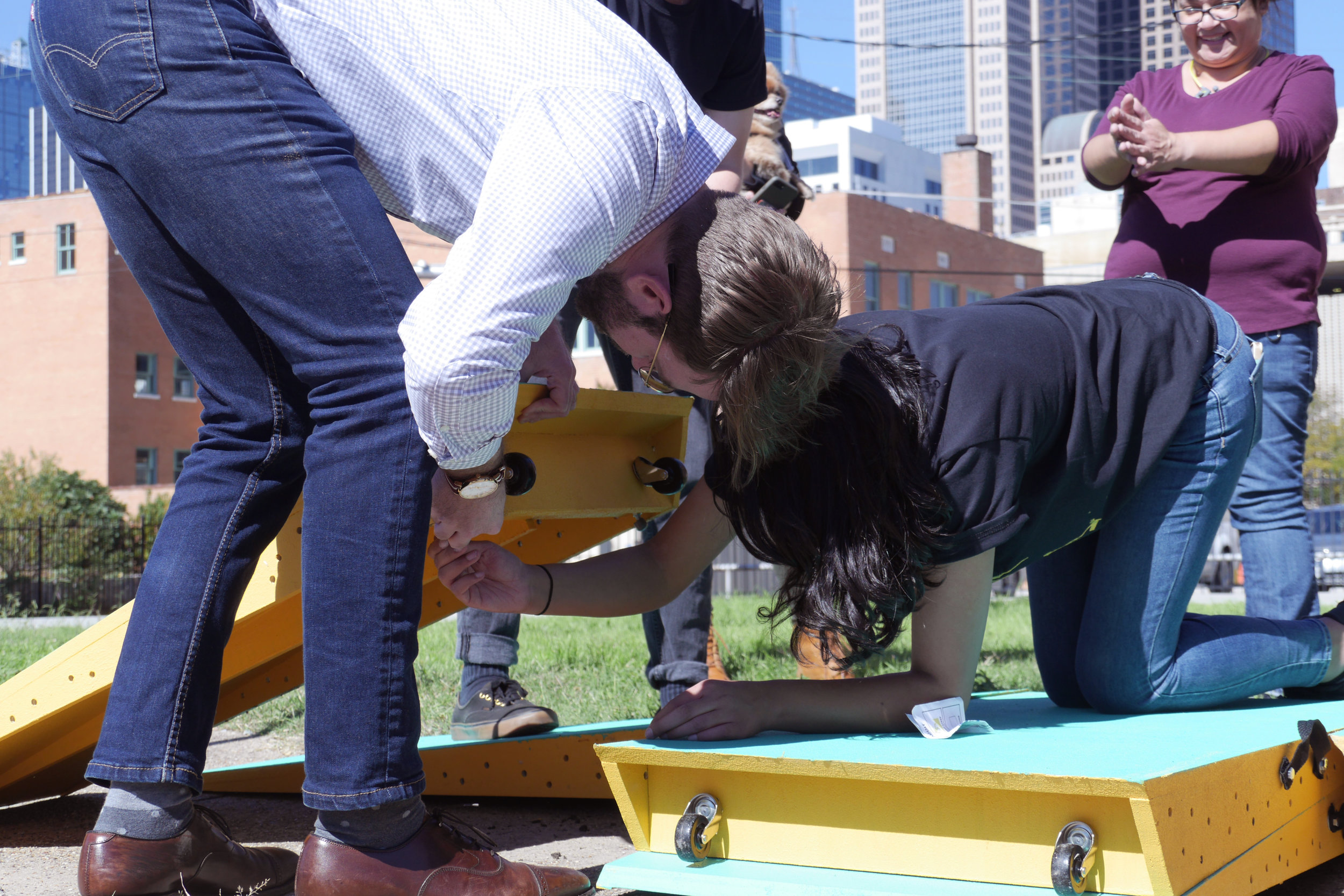

This fall [bc]’s Bridging the Block project set out to hear from Dallasites about some of the challenges they face when trying to use the sidewalks of Downtown Dallas. Through a series of design meetings and a tour, participants identified the biggest problems hindering mobility, and workshopped design solutions. The most pressing issues singled-out included broken and narrow sidewalks, steepness of driveways, a lack of curb cuts, visibility issues, and poles or debris blocking the public.
[bc] and participants concluded that recognizing an issue can be the first step to solving it, and that people often don’t recognize something is a problem unless they have been personally impacted by it or know someone who has. This understanding framed the approach to the final installation: not only would the final product include a method to address the issues seen and discussed, it would also make it a point to highlight the issues and the various populations they alienate on a daily basis.
The final work is a kit of parts that together create different configurations of temporary “bridges” on the sidewalks of Marilla Street between City Hall and the Farmers Market - a stretch of sidewalk in such poor condition that it is extremely difficult to navigate. These “bridges” are mobile installations that raise awareness of accessibility issues in public space and celebrate creating a city accessible to everyone. To accompany the bridges, [bc] built a series of signs featuring pictographs and text that explain the challenges the ramps address. As a whole, the installation uses color, texture, and modularity to create awareness about the breadth of mobility challenges and experiences in public space.
There will be another opportunity to see the installations at the #MarillaMakeover Grand Opening on Friday, Nov. 16, 11:30 am - 2:00 pm.
The Bridging the Block project is supported by AARP and coincides with the #MarillaMakeover Project currently being led by Downtown Dallas Inc. and the City of Dallas’ Planning and Urban Design Department.
El Sonido del Agua Workshops
Alongside our partners La Union del Pueblo Entero (LUPE), A Resource in Serving Equality (ARISE), the Narciso Martinez Cultural Arts Center, and four selected musicians (Frutoso Villareal, Jonathan Salinas, Refugio Ortiz, and Juan Manuel Alejo) we have recently wrapped up a series of three songwriting workshops in the Alberta Meadows and Owassa Acres colonias.
In July, a workshop was held at each colonia where musicians, residents, and partner organizations came together to write corrido verses following discussions about daily life and the impact of flooding in the colonias. The workshops began a walk around the neighborhood and a Colonia Audit of Public Spaces (CAPS), where the residents recorded the physical conditions and their thoughts on spaces in the community focusing on areas related to drainage, flooding and safety. Musicians participated in the audit as well to hear about challenges and success stories within the colonias. After walking the neighborhood, the musicians performed some of their music and spoke about the corrido process and the musical elements that make a compelling corrido. Residents discussed the music performed and then began to write their own stories as corrido verses.
The second round of workshops took place in early September. During these workshops, groups worked collaboratively to write corrido lyrics, and residents shared out their writings. Musicians led conversations to explore the format of the song to be produced. At the end of September, residents, musicians, and partners re-convened to weave the writings produced through the second workshop into cohesive songs that represent the struggles of each colonia.
We are looking forward to continuing work with our partners, residents, and musicians to record the songs produced through these workshops and plan a dance celebration in the new year. Stay tuned for updates!
El Sonido del Agua is a multi-year creative placemaking project that supports the expression of local voice through music, and is supported by ArtPlace America.
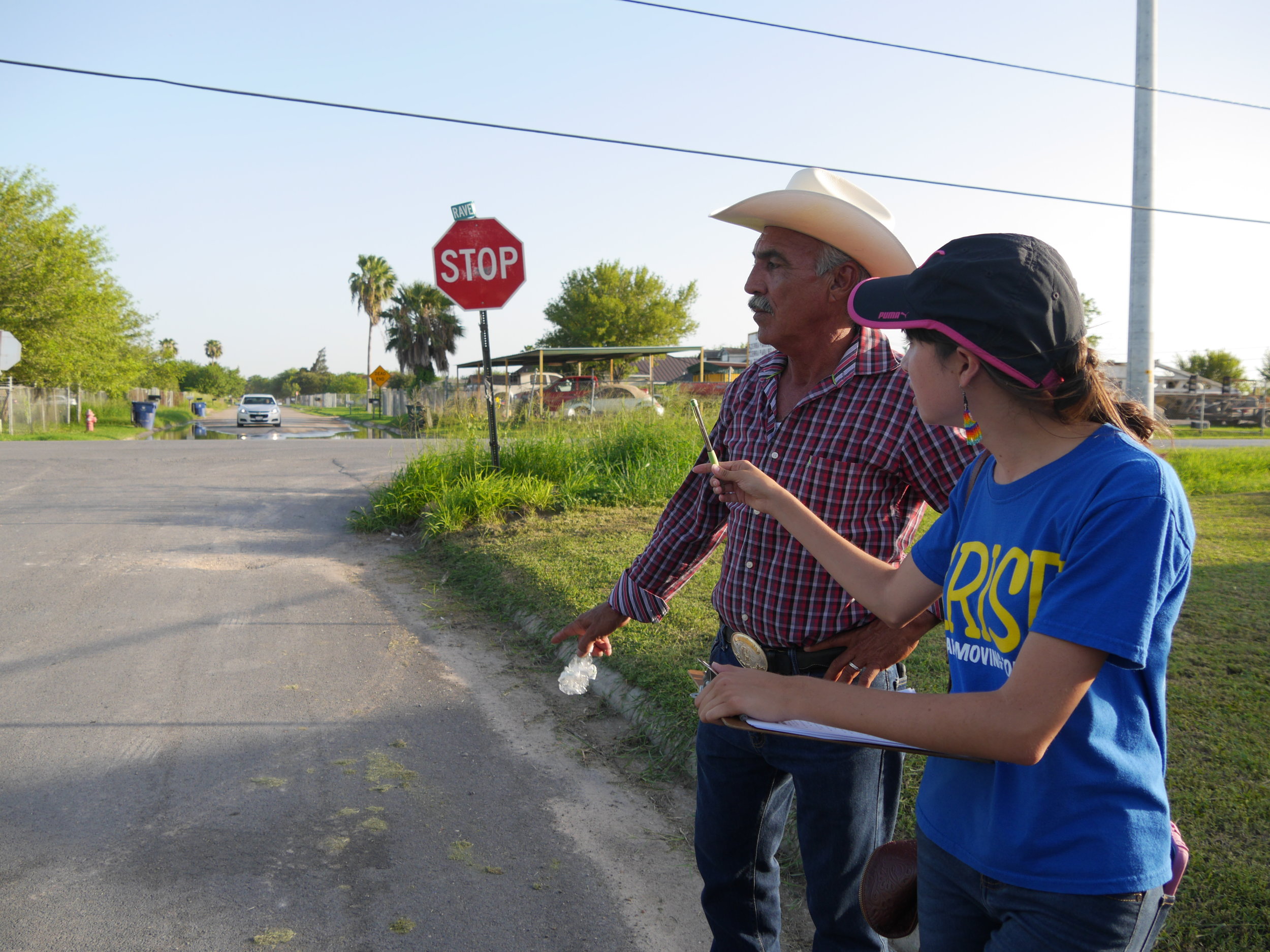
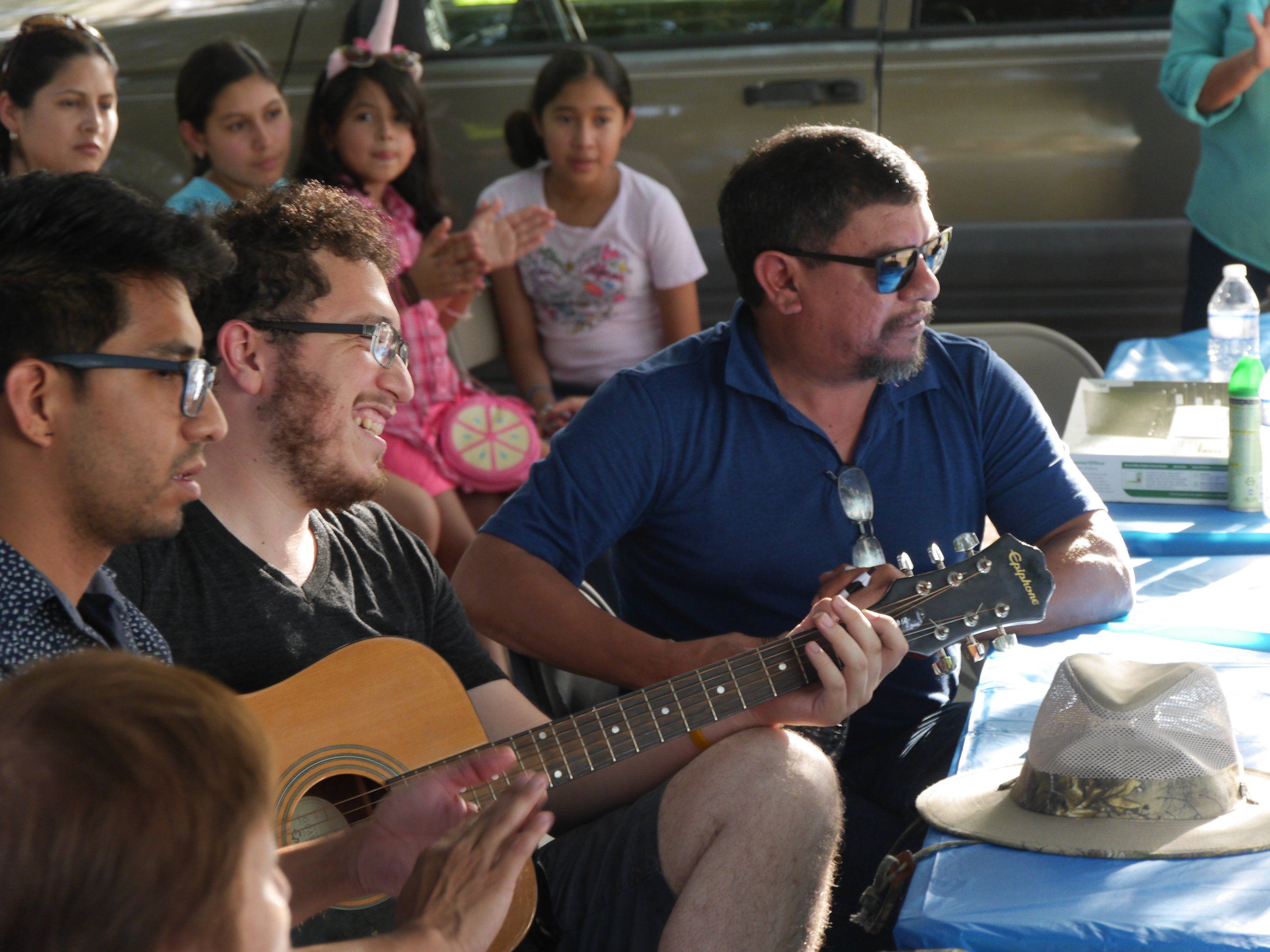
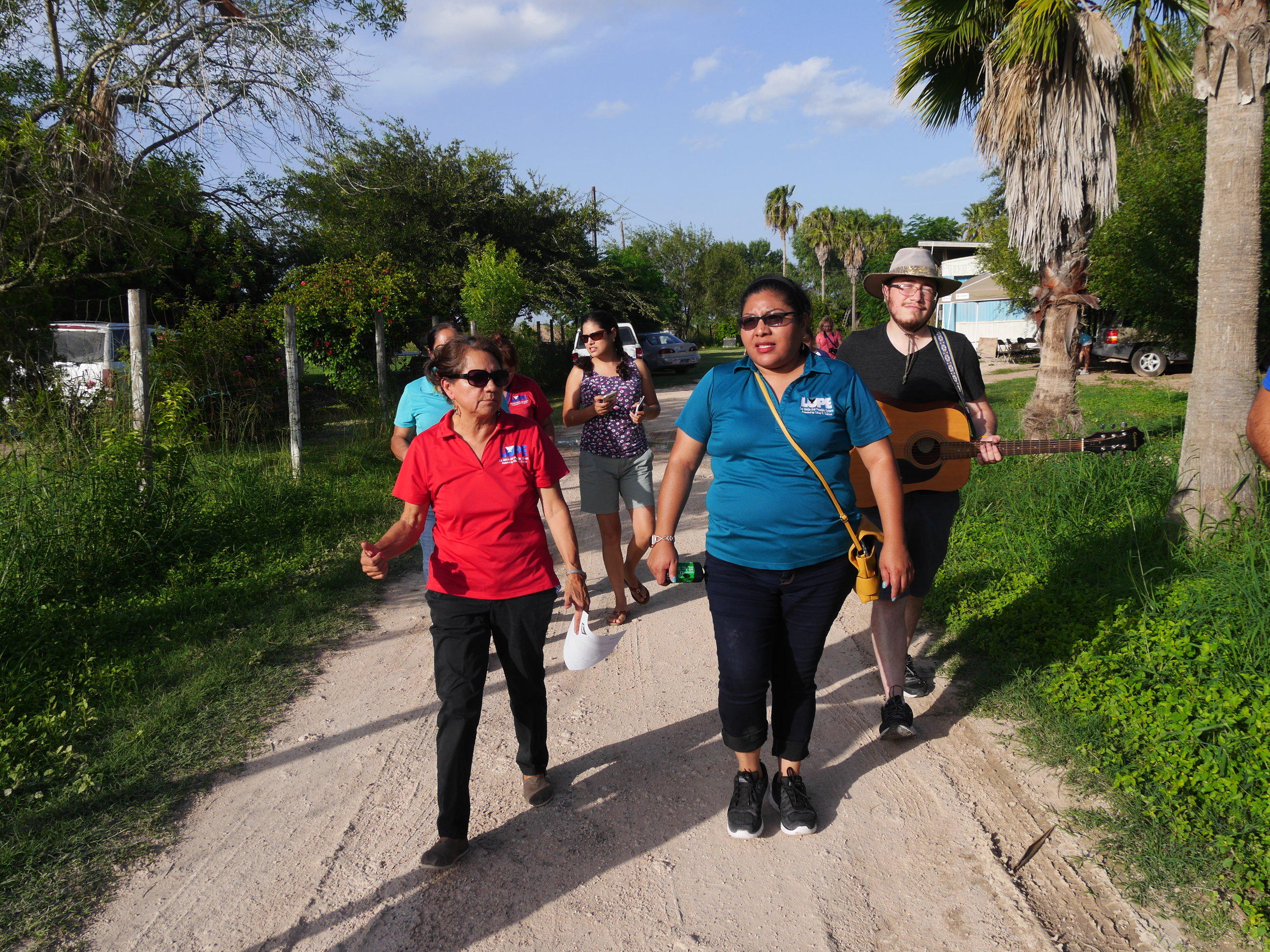
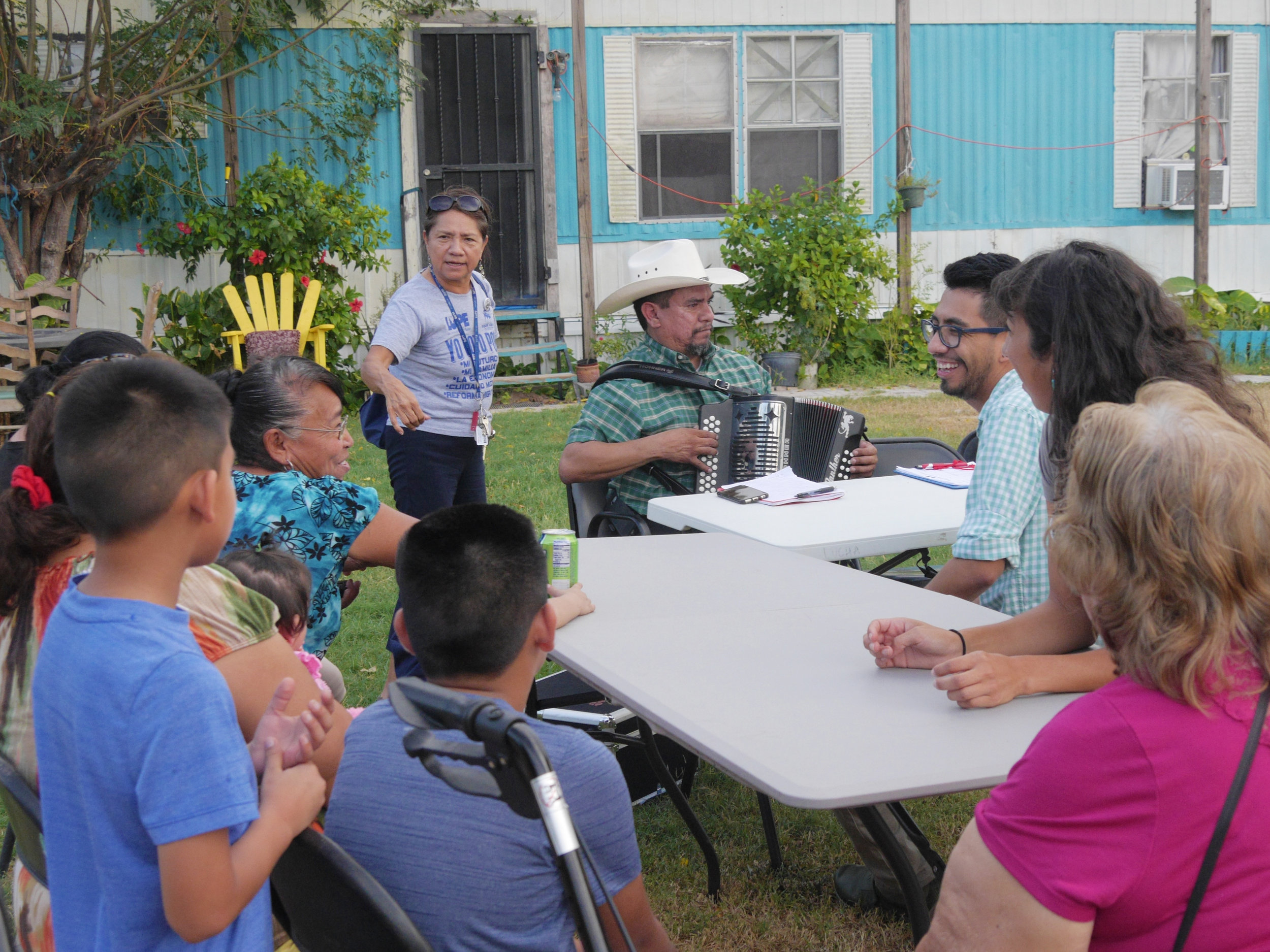
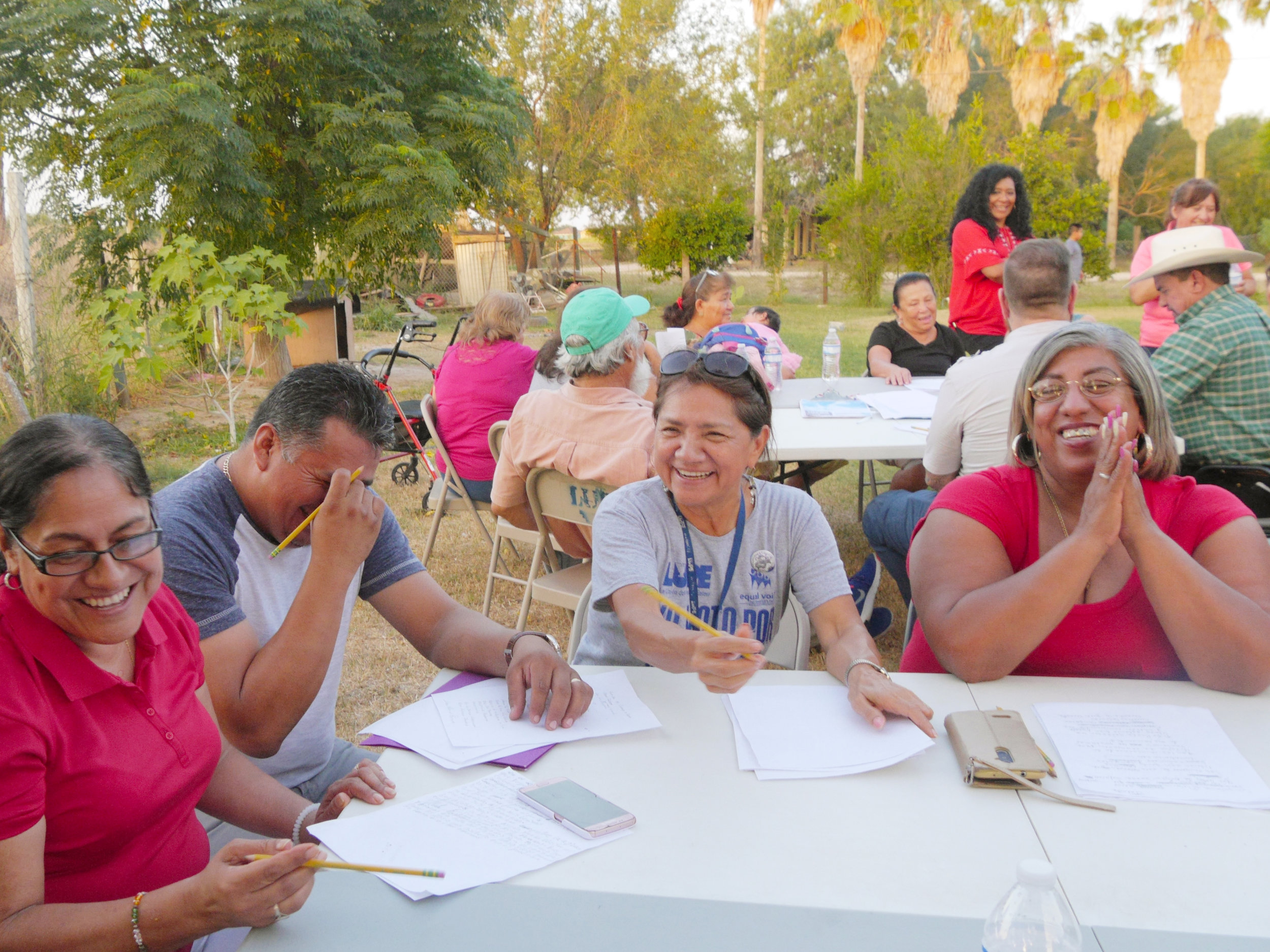
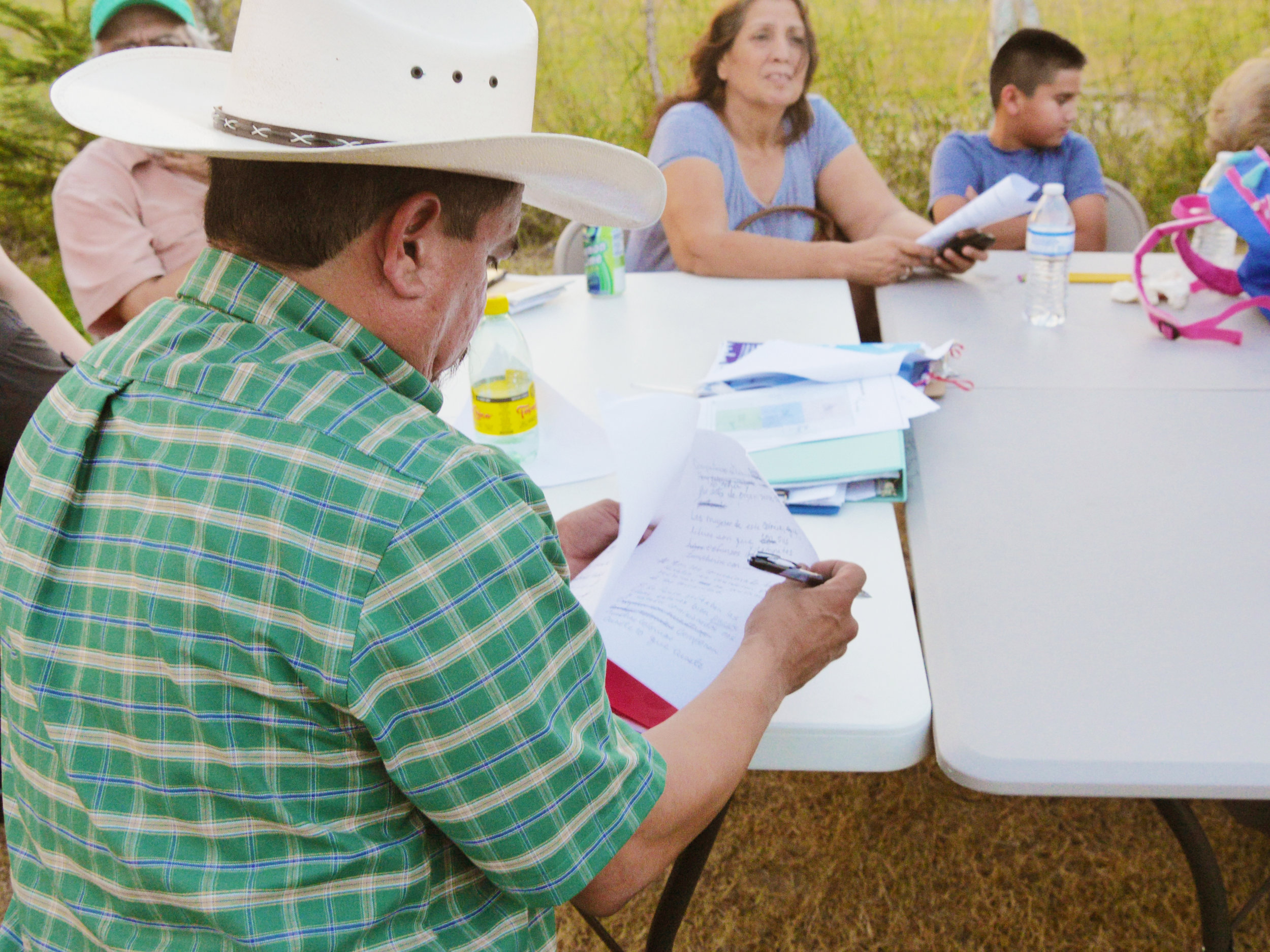

Bridging the Block
This fall [bc]’s Bridging the Block project will be installing temporary “bridges” on the sidewalks of Marilla Street between City Hall and the Farmers Market. These “bridges” will be a group of mobile installations that aim to raise awareness of accessibility issues in public spaces and celebrate creating a city accessible to everyone.
We have held several community design meetings to hear from people about their experiences as a pedestrian in downtown Dallas and the ways they would approach addressing the issues at hand. The meetings set out to identify accessibility issues and have conversations about who would be impacted by these limitations. We learned from participants about the challenges of broken and narrow sidewalks, steepness of driveways, a lack of curb cuts, visibility issues, and poles or debris blocking the paths.
The conversations touched on whether minimum accessibility requirements were sufficient in addressing the needs of all. One issue identified was the challenge of navigating textured pavers found at crosswalks with a walker. Another topic of concern was safety and the small but important design decisions that could address this concern—from street lights to reflective materials that would indicate the presence of a pedestrian to oncoming traffic.
The Opening Day Lunch and Conversation will be on Friday, Nov. 2, 12:00 to 1:30 pm. You will have another opportunity to see the installations at the #MarillaMakeover project Grand Opening on Friday, Nov. 16.
The Bridging the Block project is supported by AARP and will coincide with the #MarillaMakeover project currently being led by Downtown Dallas Inc. and the City of Dallas’ Planning and Urban Design Department.
Harold Simmons Park Public Workshops
[bc] is serving as a consultant to the Trinity Park Conservancy, bringing our skill set in public interest design to engage Dallas' communities around the future of Harold Simmons Park, 200 acres along the Trinity River. Engagement efforts will focus on discovering how Dallas residents currently use parks and public space while encouraging them to re-imagine what this area could be. This understanding will inform the design of the 200 acre Harold Simmons Park.
Join us as we support the Trinity Park Conservancy in envisioning the future of the Harold Simmons Park as a public space that connects Dallas residents to each other and nature. Starting September 15th, the Conservancy will host 10 public workshops across the city to reimagine our river. For more about Harold Simmons Park, click here. Click here to RSVP to the upcoming workshops.
Four Musicians Selected for El Sonido del Agua
On June 13, 2018 the musician selection committee—comprised of community organizers, conjunto musician experts and designers—reviewed applications and held live auditions at the ARISE Support Center in Alamo, TX. The Support Center is just a few miles from Alberta Meadows and Owassa Acres, two colonias which are focus areas for the project.
Four musicians rose to the top of the list during this session and the committee thought that finding a way for the four of them to work together would foster the best possible outcomes for the project. Two of the musicians are from the colonias themselves (one each from Alberta Meadows and Owassa Acres). The other two live in the Rio Grande Valley and have experience working with colonias. This combination of local expertise and regional understanding of drainage and music should make for a lively experience!
We will announce the musicians at the July 11 and 12 songwriting workshops and community audits, to take place in the colonias. These events will kick off the next phase of the project. Musicians will lead corrido writing writing workshops, following walking community audits led by [bc]. The community audits are designed to support residents of the colonias in identifying, documenting, and reporting infrastructural issues that impact drainage and catalyze conversations about the challenges of daily living in a flood prone area. These audits and conversations will be a foundation for writing corridos (narrative ballads) about these conditions.
Additional workshops will be held this summer to refine the corridos and then produce conjuntos based on these stories. This effort to put the daily struggles that colonia residents face into song is at the heart of El Sonido del Agua.
This project is supported by a grant from the ArtPlace America National Creative Placemaking Fund.
El Sonido del Agua Call for Musicians - deadline for submission extended to JUNE 15!
We are thrilled to announce the Call for Musicians for "El Sonido del Agua," a multi-year creative placemaking project supported by ArtPlace America.
The deadline for submissions has been extended to JUNE 15!
As part of this project, we will commission one or more local corrido writers / conjunto musicians to lead workshops with colonia residents and collaboratively write corridos that speak to residents’ experiences of flooding and other stormwater issues in the colonias.
The call for musicians is below:
Convocatoria para Músicos de Conjunto Regional / Compositores de Corridos
El Sonido del Agua - Valle del Rio Grande
Convocatoria de Músicos empieza: 5-17-18
Fecha límite para entregar solicitud: 6-15-18
Favor de enviarla escrita o verbalmente
Para preguntas:
Para preguntas sobre el proyecto contacte a Thor - thor@bcworkshop.org
Envíe preguntas en Español a Martha - martas@lupenet.org o Laura - laura.arise94@gmail.com
Envíe preguntas sobre los talleres de música a Rogelio - nrogelio@hushmail.com
Descripción del Proyecto:
buildingcommunityWORKSHOP ([bc]) se complace en anunciar la convocatoria de propuestas de músicos para El Sonido del Agua, un proyecto que asociará a residentes de colonias con escritores de Corrido / músicos de Conjunto.
El Sonido del Agua es un proyecto de ritmo acelerado y altamente colaborativo. Los músicos trabajan con residentes, organizadores comunitarios, expertos en políticas y salud pública, diseñadores y planificadores, trabajadores de la ciudad y del condado y más. Los músicos seleccionados para el proyecto le enseñarán a residentes de colonia cómo escribir corridos que respondan y se enfoquen en los problemas relacionados con el drenaje, las inundaciones y los huracanes al igual como los problemas afectan su vida cotidiana. Dependiendo de los resultados de los talleres se seleccionarán múltiples Corridos para que se produzcan en Conjuntos.
Los músicos deberían estar dispuestos a trabajar en colaboración con los líderes de las colonias y aliados comunitarios y deberán ser capaces de enseñar como escribir canciones y ser músicos de Conjunto o socios de los músicos de Conjunto.
La línea de tiempo del proyecto es la siguiente:
- Convocatoria de lanzamiento de músicos - 5-15-18
- 1er Auditoría comunitaria - Observar condiciones secas - 6-11-18
- Preguntas - formato de seminario web - 6-13-18
- Llamada para músicos - 6-15-18
- Selección y notificación de músicos - 6-15-18
Actividades de Talleres:
- 2da Auditoria comunitaria - condiciones después de la lluvia - TBD
- 1er Taller de Corridos - TBD
- 2do Taller de Corridos - TBD
- 3er Taller de Corridos - TBD
- Finalización del Corrido - JULIO
- Composición de letra musical con conjunto - AGOSTO
- Funciones / Sesiones de Música - SEPTIEMBRE - OCTUBRE
- Celebraciones en la Colonia - OCTUBRE - NOVIEMBRE
Esta iniciativa está respaldada por el patrocinio de ArtPlace America. Para conocer más sobre ArtPlace America, visite el sitio web: www.artplaceamerica.org
PRINCIPIOS DEL PROYECTO
Las presentaciones de propuestas deben enfocarse en este proyecto musical en colaboración con los miembros de la comunidad utilizando los principios de guia y el proceso de Activacion Vacantes [bc] que se encuentran a continuación:
- Los corridos deben versar sobre la vida cotidiana, las inundaciones, los huracanes y las travesías que les trajo, incluyendo los problemas relacionados con la salud pública, la vivienda digna y las condiciones de vida.
- El proyecto debe ser impulsado por objetivos definidos y articulados por los residentes de un lugar en particular
- Debe elevar las voces y motivar la participación cívica
- Fortalecer la identidad del vecindario y la historia cultural, desafiando las normas, incluida la aburguesación y el desplazamiento
- Fomentar la colaboración y la participación creativa entre un conjunto diverso de personas, que culmina en un trabajo co-creado por el artista y la comunidad
- Empoderar a los residentes para abordar el futuro de su propio vecindario y buscar mayores resultados relacionados con los objetivos de la comunidad
- Cambiar las percepciones de los desafíos
Para más información en procesos de Activación Vacantes se pueden encontrar aqui.
¿Quienes pueden ser candidatos?
Todo tipo de músico(s) que viva en los El Valle del Rio Grande en EE.UU es elegible a participar y se le invita a enviar una solicitud. Los músicos deben demostrar un gran interés en la justicia social y un gran deseo de trabajar en colaboración con partes interesadas de diversos orígenes económicos y culturales. Los músicos interesados en participar en el diseño, proyectos comunitarios, la planificación urbana o en la creación de espacios creativos son especialmente alentados a presentar solicitudes y aplicar. Las solicitudes son abiertas para ambos grupos colectivos e individuos.
PREMIO DEL PROYECTO
El presupuesto musical es de $ 30,000. Esto se puede otorgar a un o más de un músico, dependiendo de la calidad de la solicitud y su propuesta. El presupuesto incluye la participación en los eventos mencionados anteriormente y el trabajo del músico. Los músicos deberán participar en una auditoría de colonias para informarse de la vida cotidiana de los residentes. Este evento brindará a los músicos la oportunidad de conocer a los residentes y conocer a la comunidad. La programación de este evento puede incluir un recorrido a pie u otros eventos similares para ayudar a presentar a los vecinos a los músicos.
INSTRUCCIONES PARA ENTREGAR SOLICITUD Y PROPUESTA
Las solicitudes se pueden enviar en línea aquí, o verbalmente con Laura o Martha. El personal de [bc] está feliz de ayudar a los solicitantes a completar su solicitud en cualquier momento del proceso. Todas las preguntas de los solicitantes pueden dirigirse con Thor Erickson a el correo electrónico: thor@bcworkshop.org
Todas las aplicaciones requerirán:
- Información del solicitante: nombre, dirección, número de teléfono, correo electrónico y sitio web (si corresponde)
- Biografía del Músico (700 caracteres)
- Testimonio escrito del músico (700 caracteres)
- Un testimonio que proclama la experiencia y el interés en trabajar en colaboración con las comunidades durante el desarrollo de la música
- Propuesta de proyecto (900 caracteres)
- Especifique el interés y el enfoque del artista para ayudar con las prioridades establecidas de la comunidad
- Mencione cómo se relacionaría el trabajo con los principios de activación de vacantes
- Mencione cómo el músico trabajará con los residentes a través de talleres
- Describa el enfoque y si el músico tiene cualquier otro formato que prefiera que el esquema anterior.
- Describe cómo el músico creará el Corrido con un Conjunto
- Incluya un presupuesto preliminar que describa los gastos y las redistribución de todas las personas involucradas.
- Muestras de trabajo y descripciones: Los músicos pueden proporcionar hasta 5 muestras de trabajo. Todos los enlaces e imágenes deben compilarse en un PDF, menos de 10 MB.
- Medios de audio y / o video: hasta 3 de las muestras de trabajo pueden ser de audio o video. Si usa Vimeo, Soundcloud o YouTube, no proteja con contraseña los enlaces multimedia. El tiempo total de audio o video enviado para las 3 muestras de medios no debe exceder los 6 minutos. Todos los enlaces deben estar relacionados con la hora de inicio.
- Documentación fotográfica de trabajo de audio / video y trabajo en 2D / 3D: las fotos deben tener 72 ppp, no menos de 800 píxeles y no más de 1100 píxeles a lo mucho. El tamaño total del archivo de cada imagen no puede superar los 10 MB.
- Para cada muestra de trabajo favor de incluir:
- El título, año y dimensiones
- El rol del artista en la producción de la obra
- Descripción breve del trabajo
- Solo si aplica, incluya una breve descripción de cómo se utilizó el compromiso de la comunidad para crear o compartir el trabajo
SCORING
Las solicitudes serán evaluadas por [bc] y el Comité Asesor, según los siguientes criterios:
- La alineación del solicitante con los valores del proyecto
- La experiencia del solicitante involucrando a la comunidad de maneras innovadoras, creativas y consideradas
- La experiencia del solicitante de trabajar en grupo con restricciones de tiempo y una fecha límite
- El interés expresado por el solicitante de trabajar con los residentes de la colonia y los socios del proyecto
- El interés del solicitante en incorporar los datos recopilados a través de la auditoría
- La fortaleza de la capacidad de los solicitantes para incorporar principios estéticos para abordar desafíos basados en la comunidad
- Originalidad, competencia y consistencia de los solicitantes a través de muestras de trabajo
ALIADOS EN ESTE PROYECTO
- LUPE
- ARISE
- TXLIHIS
- Narciso Martinez Cultural Arts Center
- UTRGV - Director of Estuary, Environmental and Special Projects (Cameron County Region)
- University of Texas School of Public Health
- Department of Population Health and Behavioral Sciences, UTRGV School of Medicine
RECURSOS ADICIONALES
Call for Conjunto Musicians / Corrido Writers
El Sonido del Agua - Rio Grande Valley
Call for Participation Release Date: 5-17-18
Application Deadline: 6-15-18
Submit Via Typeform, or verbally
Contacts:
Questions about the project Thor - thor@bcworkshop.org
To submit verbally Spanish Martha - martas@lupenet.org or laura.arise94@gmail.com
Questions about the workshops - Rogelio - nrogelio@hushmail.com
PROJECT OVERVIEW
buildingcommunityWORKSHOP ([bc]) is excited to announce the call for proposals from teaching musicianfor El Sonido del Agua, a project that will partner colonia residents with Corrido writers / Conjunto musicians.
El Sonido del Agua is a quick paced and highly collaborative project. Musicians will get to know residents and stakeholders, community organizers, public health and policy experts, designers and planners, City and County workers, and more. The musicians selected for El Sonido del Agua will teach residents how to write Corridos that respond to and address issues related to drainage, flooding, and hurricanes and the dealings of daily life through these storm events. Depending on workshop outcomes, multiple Corridos may be selected to be produced into Conjuntos.
The musicians should be willing to work in collaboration with colonia leaders and local stakeholders, should be able to teach songwriting, and either be a Conjunto musician or partner with Conjunto musicians.
The timeline of the project is as follows:
- Call for musicians release - 5-15-18
- Community Audit 1 - 6-11-18
- Q&A for applicants and auditions - 6-13-18
- Applications due - 6-15-18
- Selection and notification of musicians - 6-15-18
Workshop activities:
- Community Audit 2 - wet after rain - TBD
- Corrido Workshop 1 - TBD
- Corrido Workshop 2 - TBD
- Corrido Workshop 3 - TBD
- Corrido finalization - JULY
- Conjunto writing - AUGUST
- Performances - SEPTEMBER - OCTOBER
- Colonia celebrations - OCTOBER - NOVEMBER
This initiative is supported by ArtPlace America. To learn more about ArtPlace America visit www.artplaceamerica.org
PROJECT PRINCIPLES
Proposal submissions should focus on this music project in collaboration with community members utilizing [bc]’s Activating Vacancy guiding principles and process found below:
- Corridos should be about daily life, flooding, hurricanes, and living through this including issues related to public health, fair housing, and general living conditions.
- The project as a whole should:
- Be driven by a set of goals defined and articulated by the residents of a particular place.
- Elevate voices and encourage civic participation.
- Strengthen neighborhood identity and cultural history, challenging norms, including gentrification and displacement
- Foster collaboration and creative participation between a diverse set of individuals, culminating in a work co-created by artist and community
- Empower residents to address the future of their own neighborhood, and pursue larger outcomes related to community goals
- Shift perceptions of challenges
More information on the Activating Vacancy process can be found here.
ELIGIBILITY
Musicians of all disciplines living in the United States Lower Rio Grande Valley are eligible to apply. Musicians should demonstrate a strong interest in social justice and desire to work collaboratively with stakeholders from diverse economic and cultural backgrounds. Musicians with interests in design, community-engaged projects, urban planning or creative placemaking are especially encouraged to submit applications. Individuals and collectives/groups are welcome to apply.
PROJECT AWARD
The total budget for the musician stipend is $30,000. This may be awarded to 1 or more than 1 musician depending on scope of application and thoroughness. This fee should include participation in the events listed above, and the unique approach of the musician. Musicians will be required to participate in a colonia audit to inform their understanding of residents' daily experiences. This event will provide musicians with the opportunity to meet residents and learn about the community. Programming for this event may include a walking tour or other similar events to help introduce neighbors to the musicians.
SUBMISSION INSTRUCTIONS
Applications may be submitted online here, or verbally to Martha or Stephanie. [bc] staff are happy to support applicants in the completion of their application at any point in the application process. All applicant questions can be directed to Thor Erickson at thor@bcworkshop.org.
All applications will require:
- Applicant Information: name, address, phone number, email and website (if applicable)
- Musician Bio (700 characters)
- Musician Statement (700 characters)
- A statement that proclaims experience and interest in working collaboratively with communities during the development of music
- Project proposal (900 characters)
- Specify artist’s interest in and approach to addressing stated community priorities
- Address how the work would relate to Activating Vacancy principles
- Address how musician will work with residents through workshops.
- Describe approach and if the musician has any other format they prefer than the outline above.
- Describe how musician will merge the Corrido with a Conjunto
- Preliminary budget that describes expenses and stipends to all people involved.
- Work Samples and Descriptions: Musicians can provide up to 5 work samples. All links and images should be compiled into one PDF, less than 10MB.
- Audio and/or Video Media: Up to 3 of the work samples can be audio or video. If using Vimeo, Soundcloud, or YouTube, do not password protect media links. The total time of audio or video submitted for all 3 media samples should not exceed 6 minutes. All links must be cued to the start time.
- Photo Documentation of Audio/Video work and 2D/3D Work: Photos should be 72 DPI, no smaller than 800 pixels and no larger than 1100 pixels on the long side. The total file size of each image can be no larger than 10MB
- For each work sample include:
- Title, year and dimensions
- Role of the artist in the work’s production
- Brief description of the work
- If applicable, brief description of how community engagement was used to create or share the work
SCORING
- Applications will be evaluated by [bc], and the Advisory Committee, based upon the following criteria:
- Applicant’s alignment with project principles
- Applicant’s experience engaging communities in innovative, thoughtful and creative ways
- Applicant’s experience working collaboratively within time restraints and on deadline
- Nuance and strength of applicant’s expressed interest in working with colonia residents and project partners
- Applicant’s interest in incorporating data collected through the audit
- Strength of applicants ability to incorporate aesthetic principles to address community based challenges
- Originality, proficiency and consistency of applicants work samples
PROJECT PARTNERS
- LUPE
- ARISE
- TXLIHIS
- Narciso Martinez Cultural Arts Center
- UTRGV - Director of Estuary, Environmental and Special Projects (Cameron County Region)
- University of Texas School of Public Health
- Department of Population Health and Behavioral Sciences, UTRGV School of Medicine
ADDITIONAL RESOURCES
Lessons from the Field: Reflections on Rural Placemaking
Find our more about our Rural Placemaking work!
Over the past year, [bc] and the Housing Assistance Council (HAC) have had the opportunity to investigate how tools of arts and community building can be used in rural communities, funded in part by a generous Knowledge Building Grant through the National Endowment for the Arts (NEA).
This partnership has brought resources to existing local efforts and enabled our organizations to better understand how ‘creative placemaking’ works in practice in rural communities and why it is a valuable tool for rural community development now. Through webinars, an internal working group, two pilot projects (in Kinston, North Carolina and Thomas, West Virginia) and a peer-to-peer exchange, we’ve seen the value of vivid local examples in understanding that ‘creative placemaking’ has been happening for a long time in rural communities across the country. Modest increases in resources coupled with capacity building hold vast potential for rural and tribal communities.
We've published a report, Lessons from the Field: Reflections on Rural Placemaking describing our yearlong initiative and reflecting on the last year of our work, outlining key outcomes and lessons learned valuable to the larger practice of rural creative placemaking. Read the full report here.
Several resources were developed during this partnership to expand knowledge and practice of rural creative placemaking, including:
- Summer 2017 Edition of Rural Voices
- Webinar 1: Creative Placemaking 101 + Funding Opportunity
- Webinar 2: Why Creative Placemaking? On the Ground Impacts
This project is supported in part by an award from the National Endowment for the Arts. To find out more about how National Endowment for the Arts grants impact individuals and communities, visit www.arts.gov.
Activating Vacancy Downtown Dallas Recap
For the Activating Vacancy Downtown Dallas, a National Endowment for the Arts-supported project in partnership with Downtown Dallas, Inc., two artist teams worked with community members to create works of public art to activate spaces in Downtown Dallas. Through a call for proposals, artists were tasked with devising a project in response to public space priorities, identified through our Community Audited Public Space (CAPS) process and a Community Advisory Committee. Two series of works were created through a community-engaged process: the WonderPhones and MAY I // a blessing project. Project teams engaged with community members through a variety of workshops and community gathering events, which included project tours and a culmintaing public interview with the artists.
WonderPhone
The WonderPhone is an interactive payphone that connect the people in downtown Dallas to the city and each other. The team combined old and new technology to allow people to listen to content and play and record their stories. Five WonderPhones were created, placed in colorful enclosures in various locations downtown and popping up at events.
The WonderPhone team (Rickey Crum, Gray Garmon, Katie Krummeck, Edward Li, and Justin Childress) worked with local high school students, architects, historians, designers, urban planners, musicians and essayists to create and record engaging Dallas- or phone-related content for participants to enjoy. Audio content ranged from personal stories of memories downtown to future imaginings of new possibilities for Downtown, as well both curated and newly created pieces that focus on the history and architecture of downtown Dallas. Interactive prompts ask participants to share reactions to specific questions (and hear responses live) as well as follow instructions to participate in immersive experiences exploring downtown.
The artists said, "We hope that the WonderPhone will inspire participants to listen and think deeply about the lived experiences of the citizens of Downtown Dallas as well as engage participants in activities to help them observe Dallas in a new light and reflect on their own participation in the city."
MAY I // a blessing project
MAY I // a blessing project is a walkable installation of blessings written by local young women for the Dallas community, manifested large-scale. The artists Ruben Carrazana and Janielle Kastner worked with a group of young women (ages 12-18) who wrote specific declarations of hope for themselves (MAY I), for their community (MAY WE), and for their spaces (MAY THIS SPACE).
The team issued an exhortation to the city: "We believe these young women don’t need us to 'empower' them, they need us to acknowledge they already have the power to speak life into their community. We call these declarations blessings as they begin with the word 'may' - a word that summons into existence that which isn’t here yet. Our work as artists has been taking their words and manifesting them in unexpected places downtown in a bold, surprising, even defiant manner. In a world that asks them to shrink, MAY I radically insists young women take up extraordinary amounts of space. We encourage you to join these young women and manifest your own blessing in your spaces, tagging #mayiblessdallas."
Our partner DDI will continue to use the artworks to activate spaces in downtown Dallas. Check out photos of the artworks and the AVDD events below!
This project was supported in part by an award from the National Endowment for the Arts (NEA). To find out more about the National Endowment for the Arts visit www.arts.gov.
To find out more about our project partner Downtown Dallas Inc., visit www.downtowndallas.com.
Rural Placemaking Peer Exchange in Thomas, WV
Learn more about our work Activating work!
On October 3rd and 4th, [bc] co-hosted a peer learning exchange with the Housing Assistance Council and Woodlands Development Group in Thomas, West Virginia to share knowledge and best practices for creative placemaking in rural communities. The peer learning exchange included a range of site visits, conversations with local stakeholders, and workshops.
[bc], HAC and Woodlands were joined by rural affordable housing developers, artists, educators and local nonprofit organizations to discuss topics including funding, partnerships, program design, cultural equity and community engagement.
This project is supported in part by an award from the National Endowment for the Arts. To find out more about how National Endowment for the Arts grants impact individuals and communities, visit www.arts.gov.
Artists Selected for Activating Vacancy Downtown Dallas!
[bc] is excited to announce the selection of two artist teams for Activating Vacancy Downtown Dallas, the duo Janielle Kastner and Ruben Carranzana, and a collective formed by Rickey Crum, Gray Garmon, Katie Krummeck, Edward Li, and Justin Childress. We're excited to spend the next few months working with them and the stakeholders of downtown Dallas to create exciting and fun works of art that challenge current notions of "public space" downtown. Please join us on Saturday, August 19th, 3 pm - 6 pm at 416 S Ervay, for a mini-block party to meet the artists and talk to them about their proposals. If you can't make it this week, we'll be having a presentation and feedback session the following Saturday, August 26th, 1 pm - 3 pm at 416 S Ervay. Read on for more information about the selected artists and their project proposals!
Ophelia Underwater. Features Zoe Kerr, photograph by Carson McCain Gray
Janielle Kastner and Ruben Carranzana: Janielle Kastner is a writer, actor and performance deviser, whose social engagement work centers around the role young women play in shaping their communities, and vice versa. She was recently named Best New Playwright 2016 (Dallas Observer), and her plays include OPHELIA UNDERWATER (The Tribe, L.I.P. Service), FEED ME (Stella Adler Theatre/Playworks) and HEAVEN’S GATES, HELL’S FLAMES. Her social engagement work includes: PROJECT: BLESSING, one-on-one performance art, and PROJECT: GIRL, a trans-media installation based on interviews with young women from disparate communities. Additionally, she co-runs Dallas cult classic Shakespeare in the Bar. She holds BAs in Theatre & English from Southern Methodist University.
Shots Fired. Image courtesy of Cry Havoc Theatre
Ruben Carrazana is a local actor, director, and teaching artist. He co-directed SHOTS FIRED, a show exploring the Dallas police shootings with local youths. Ruben directs and assistant directs for JESTERS, theatre and film created and performed by adults with special needs. He has performed locally with Second Thought Theatre, Danielle Georgiou Dance Group, Dallas Theater Center, Undermain Theatre, Stage West, and Cara Mia Theatre. His play STACY HAS A THING FOR BLACK GUYS was recommended for the American Theatre Critics Association/Harold and Mimi Steinberg New Play Award, and his play SHE was awarded an Honorable Mention from the Southwest Playwriting Festival. He holds a BFA in Theatre from Southern Methodist University.
Together, Janielle and Ruben are two of the co-founders of performing arts incubator The Tribe, for which they were named 2016 Dallas Masterminds (Dallas Observer).
Project Proposal:
Together, Janielle and Ruben will transform an outdoor space in downtown Dallas, repurposing it with giant, individual, original blessings written by young women in the Dallas community (ages 12-18). First, they will draw upon their devising experience and lead young women through the creative process of writing a “blessing” for their city (a short, powerful, irreligious but specific declaration of hope). Then, they will work with community partners to determine an appropriate outdoor route. Finally, the project will culminate as a walkable installation of 8-10 aesthetically unified pieces, starting and ending with blessings projected onto buildings a few blocks from each other, with transformed “blessed” objects to be found along the way (ie. large text painted on a bench, length of sidewalk, dumpster, etc). Since young women are often taught to take up less space, projecting their words large-scale onto community spaces is a radical, inherently subversive act. Rather than seeking to “empower” young women, these pieces assert that young women already possess the requisite power to speak life into their community. As a result, the installation both realizes local young women’s visions for their city’s future, and designates a walkable space in an otherwise unwalkable city.
Mod Pod
Rickey Crum, Gray Garmon, Katie Krummeck, Edward Li, and Justin Childress: The artist team is a collective of designers from a variety of backgrounds (architecture, human-centered design, graphic design, engineering, and education) with experience working all over the world on projects of various scales. The diverse backgrounds of the team members allow them to bring an interdisciplinary perspective to design challenges, and the nature of their work has given them the platform to use creative expression and human-centered design methodologies for social impact. The whole team (Rickey Crum, Gray Garmon, Katie Krummeck, Edward Li, and Justin Childress) are all affiliated with the Design and Innovation programs (like this and this) at Southern Methodist University in Dallas, TX.
Project Proposal:
We propose to create an installation of “redesigned” payphones at various public spaces in downtown Dallas. The payphone, although antiquated, can be digitally altered with new technology and pivot to be a vessel for connecting people with their city. We will work with the downtown community to understand their needs, interests, and stories to help design the payphone interactions. As a passive listener or an active contributor, people will have the ability to choose the way that they want to engage with the installation. Ultimately, this installation aims to inform people about their city, suggest ways to experience their city, inspire deeper connections between people, and encourage them to participate in the future of their city by sharing their voice.
The internal systems of the payphone will be altered with new digital technologies to allow for the keypad to provide a series of audio interactions. When a person interacts with the payphone by picking up the receiver, they will be greeted with a message that prompts the user to engage in different activities. For instance, the user might be prompted to hear the history about a nearby building, or a historical event. An informational option could provide recommendations on local dining or entertainment offerings. They can press a number that asks the user a question about their opinion on a current civic topic and records their response. There could be an option to leave recorded stories that others can listen to and share then personal experiences.
These projects are part of [bc]'s Activating Vacancy initiative. Activating Vacancy is an art and public interest design initiative where residents work alongside artists and designers to investigate, strengthen, and share a community’s unique history; engage in the development of a physical and social framework for cultural activities; and plan for the renewal and growth of the neighborhood. Collaborations included art installations, performances and other artistic actions that explore the cultural, social, political and economic life of a neighborhood.
This project is supported in part by an award from the National Endowment for the Arts. To find out more about how National Endowment for the Arts grants impact individuals and communities, visit www.arts.gov.
Additional support is provided by Downtown Dallas, Inc.
11th Street Bridge Park Working Group
See more posts about our work in DC!
[bc] is supporting the 11th Street Bridge Park with developing cultural strategies to include in its Equitable Development Plan. On July 20th and 25th, [bc] and the 11th Street Bridge Park facilitated two small working group meetings. Local artists, arts organizations, and national leaders drafted initial strategies that identify how the Bridge Park can support arts, culture and heritage in its impact area.
These draft strategies will be shared with the public at an open house on Wednesday, August 16th.
Remembering the Fallen Officers of July 7th, 2016
Click here to read more about Little Free Libraries!
buildingcommunityWORKSHOP hosted the official opening reception of the DPD & DART Officer Memorial Little Free Libraries last Saturday, July 22nd at South Side on Lamar.
Wisconsin resident Helen Stassen, whose late son Benjamin has been commemorated through a Little Free Library in their hometown, reached out to [bc] after July 7th to initiate this endeavor and generously funded the design and construction of the five libraries.
“We are offering a small contribution to personal and community healing in the form of Little Free Libraries as memorials to the slain Dallas Officers. Since Benjamin’s death our family has embraced the positive experience of being stewards of a Little Free Library, used by many people, that is a memorial in Benjamin’s name. This offers us an evolving and ever changing way to nurture and care for others in our community and to keep Benjamin’s memory alive. May the families, friends and community of Officers receive some of these same benefits. We hope/pray those who see and use these libraries and hear this story be moved toward helping others and sharing in peaceful nonviolent ways.“
Over the last 12 months, the five Little Free Libraries have been designed, built, and installed across the City of Dallas to commemorate the five officers who lost their lives on July 7th, 2016. This project has been an opportunity for a meaningful collaboration between [bc], the Dallas Police Department's Office of Community Affairs, a team of dedicated volunteer designers, and our library stewards: South Side on Lamar, El Centro College, N W Harllee Early Childhood Center, Our Saviour Episcopal Church, and Vickery Meadow Community Garden. To realize the libraries, a group of 6 core volunteers offered their design services with help from dozens of other volunteer professionals and students. The design of the 5 libraries is composed of 5 shapes that were fabricated by hand. The libraries work together as a group, but are arranged in different compositions in each location to preserve a sense of individuality for each library.
This scheme was inspired by the police officers, who were all unique individuals who came together to work as one unit. The unique geometric qualities of each library are meant to represent this bond. Proudly painted blue and yellow, all libraries display the fallen officers’ badge numbers, the “Read in Peace” slogan, and other personal memorial items from the Stassen family that address people affected by gun violence.
The memorial libraries are part of our Little Free Library/Libros Libres program. Little Free Libraries/Libros Libres is a literacy and community based design initiative in Dallas, Texas that uses free book exchanges to build community and promote a culture of reading. Inspired by the Little Free Library movement (www.littlefreelibrary.org), these small neighborhood book shelters operate under the guiding principle of “take a book, leave a book.” The project uses community engagement and design to makes books available in a variety of publicly accessible locations, supporting the health of the neighborhoods by fostering collaboration and relationships.
We would like to thank everyone who was involved in the creation of the libraries. Over the course of the year, we had over a dozen hands involved in the design and fabrication process. The core volunteer group was led by:
Amruta Sakalker
Kristin Henry
Haven Hardage
Oswaldo Rivera-Ortiz
Freddie Ortiz
Sonya Shah
Additional support and in-kind donations were made by:
Richardson High School’s R Studio
Dallas Metal Inc.
SMU Deacon Innovation Lab
Little Free Libraries
Little Free Libraries in the press:
Little Free Libraries will honor fallen Dallas officers, Dallas Morning News, September 9, 2016.
Announcing Activating Vacancy Downtown Dallas Call for Proposals
buildingcommunityWORKSHOP, with Downtown Dallas Inc, is excited to announce Activating Vacancy Downtown Dallas’s call for artist proposals. Artists are invited to submit applications for this project that asks artists to create create work that directly addresses issues identified by downtown stakeholders through a previous process called Community Audited Public Space (CAPS), as well as by a Community Advisory Committee.
Read More![[bc]](http://images.squarespace-cdn.com/content/v1/5248ebd5e4b0240948a6ceff/1412268209242-TTW0GOFNZPDW9PV7QFXD/bcW_square+big.jpg?format=1000w)













